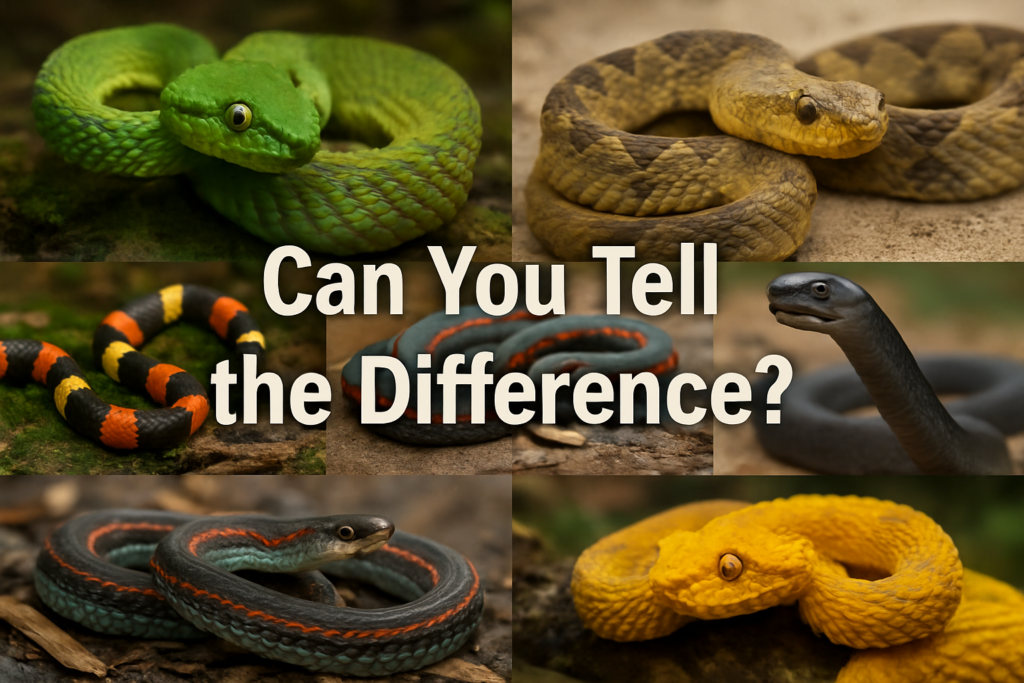
Some snakes kill with a single bite. Others want to be left alone. But when they’re all coiled, hissing, and staring you down, it’s hard to know which is which. Many harmless species mimic the looks of their venomous cousins, while some of the deadliest blend in with leaves and logs like shadows with fangs.
Think you can tell the difference? This quiz will test your instincts, your knowledge, and maybe even your nerve. From jungle vipers to backyard visitors, you’ll see 24 snakes, some fatal, some false alarms. Study the scales, trust your gut… and click carefully.
Snake #1: Eastern Coral Snake
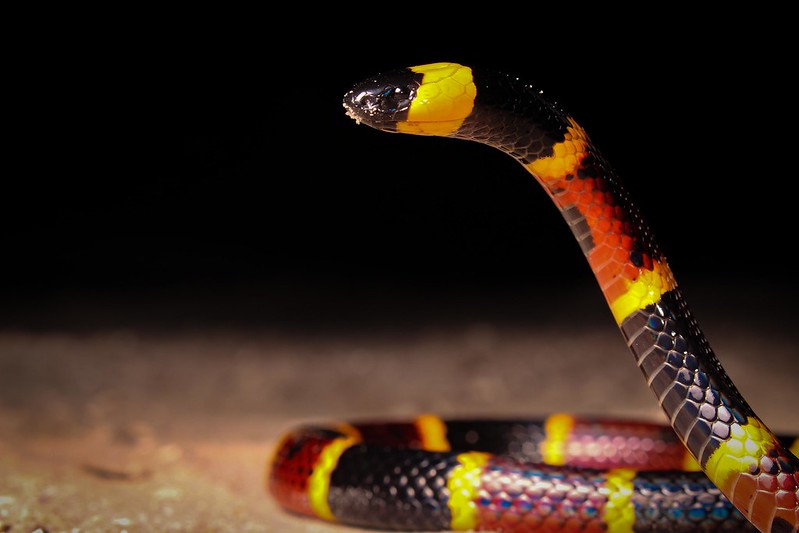
Dangerous or Not?
Slender, secretive, and stunning. This snake’s bold stripes are unmistakable, but are they a true warning, or just a bluff? Found across parts of the southeastern U.S., it rarely strikes… but when it does, you’d better hope you guessed right.
What’s your call: Deadly predator—or colorful poser?
Answer: Dangerous
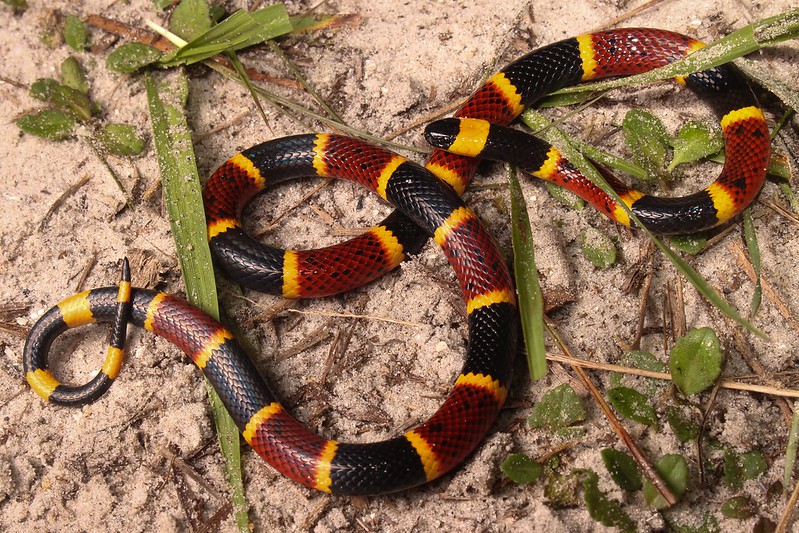
That red, yellow, and black banding isn’t just for show; the Eastern coral snake is one of the most venomous snakes in North America. Unlike pit vipers, it has small fangs and a less dramatic strike. But don’t be fooled. Its venom is neurotoxic, meaning it shuts down nerve signals and can lead to respiratory paralysis. One bite, if untreated, can be fatal.
You’ll find this snake slinking through pine forests, leaf litter, and sandy soils across the southeastern U.S., especially in Florida. It’s a secretive species, usually active at dawn or dusk, and rarely confrontational unless handled. The danger lies in its delayed symptoms; bite victims might not feel pain immediately, giving a false sense of safety before things escalate rapidly.
Fun fact: Its striking look is nature’s warning sign, but it’s so similar to the nonvenomous scarlet kingsnake that even trained eyes hesitate. That’s why the rhyme exists: “Red touch yellow, kill a fellow. Red touch black, friend of Jack.” Still, the rhyme doesn’t work outside the U.S., so don’t rely on it abroad. Source: Florida Museum
Snake #2: Eastern Hognose Snake
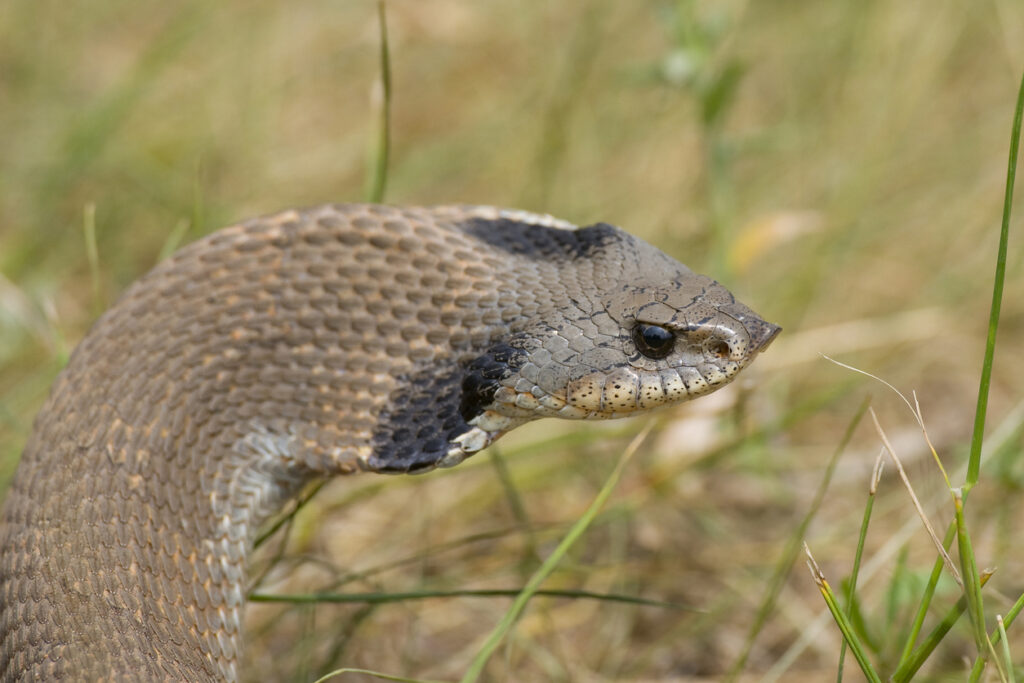
Dangerous or Not?
It flattens its neck like a cobra, hisses like a villain, and even plays dead with its tongue hanging out. Found across the eastern and central U.S., this dramatic performer makes a big scene when it feels threatened. But is it all for show, or is there real danger behind the act?
What’s your guess: Lethal threat—or just an A+ actor?
Answer: Harmless
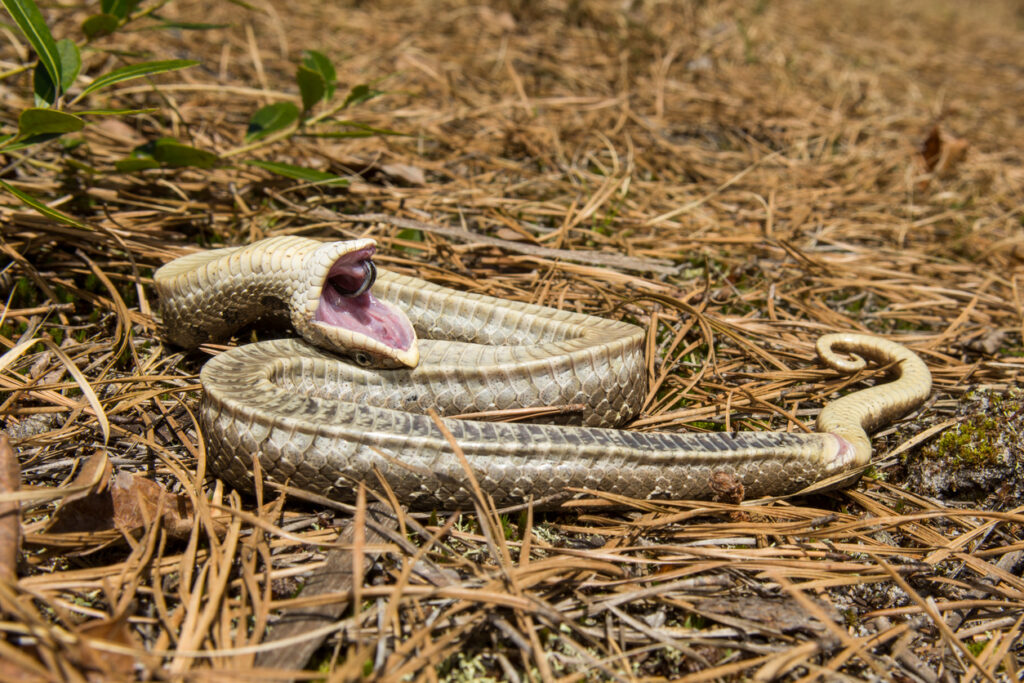
Despite the drama, the Eastern hognose snake is entirely nonvenomous to humans. Its cobra-like hood and theatrical hissing are bluff tactics designed to scare predators away. And if that fails? It takes the performance further, rolling onto its back, opening its mouth, and playing dead. Some even emit a foul musk to sell the act.
This snake mainly feeds on toads, thanks to its specialized rear fangs (used only to subdue amphibians, not people). It’s found in sandy or open woodland habitats from Florida to Minnesota. Though it looks intimidating, it’s harmless, so much so that it’s often called a “puff adder” even though it’s not related to the real, deadly kind.
Fun fact: The hognose snake doesn’t just play dead, it commits to the role. Tongue lolling out, body limp, even a little bit of musky “rotting smell” added for realism. But here’s the kicker: if you try to flip it right-side-up while it’s mid-performance? It’ll immediately roll back onto its back, as if to say, “No, really, I’m dead. Respect the drama.”
It’s nature’s version of an Oscar-winning toddler tantrum, and it works. Most predators lose interest fast when their “meal” seems spoiled. Source: Virginia Herpetological Society
Snake #3: Boomslang
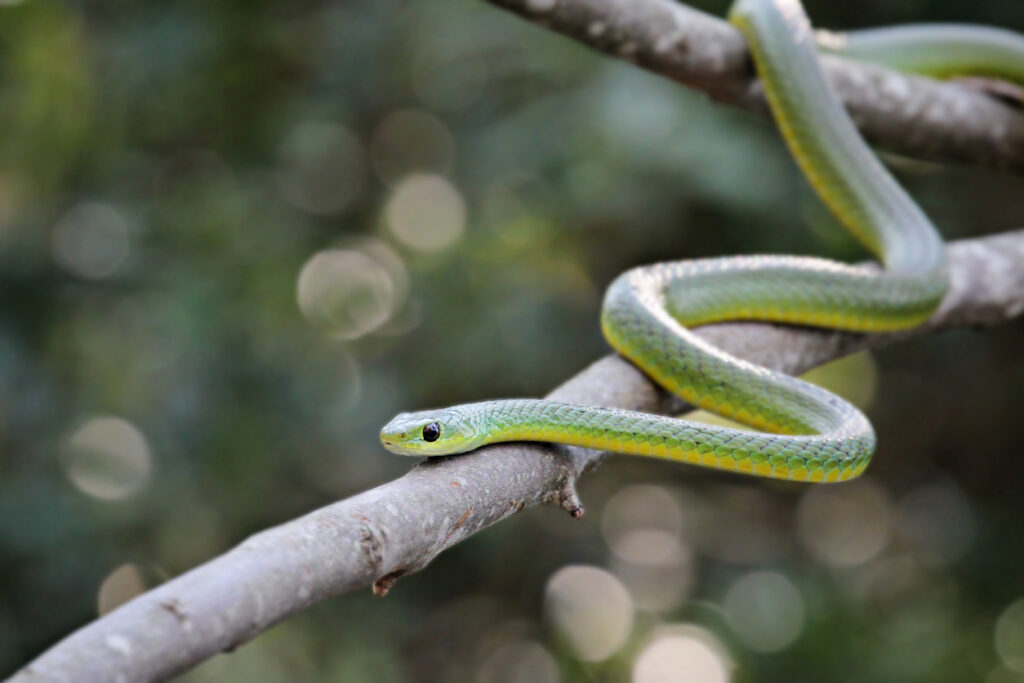
Dangerous or Not?
It has massive eyes, a gentle green body, and tends to hang out in trees. Not exactly nightmare fuel, unless you know what it’s capable of. Native to sub-Saharan Africa, this slender snake doesn’t often strike, but when it does, things can get gruesome.
What do you think: Peaceful tree-dweller or silent killer?
Answer: Dangerous
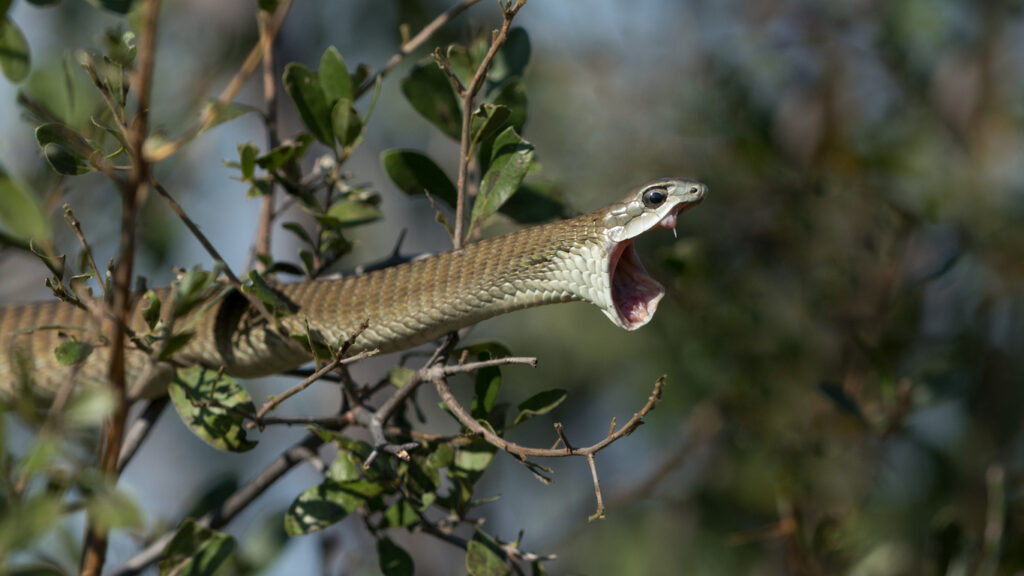
This snake may look innocent, but the Boomslang is one of Africa’s most venomous snakes and one of the deadliest if left untreated. Its venom is hemotoxic, meaning it destroys blood cells and can lead to internal bleeding, organ failure, and death. Victims may bleed from their gums, nose, and even into their eyes. The worst part? Symptoms can be delayed for up to 24 hours, fooling people into thinking they’re in the clear.
Boomslangs are rear-fanged, meaning they need to get a good bite in to inject venom. But don’t count on that being a safeguard. One famous case involved herpetologist Karl Patterson Schmidt, who documented his symptoms after a bite… right up until it killed him the next day.
Despite their potency, boomslangs are shy and rarely bite humans unless provoked or mishandled. Most people never even know one was nearby. Source: African Snake Institute
Snake #4: Milk Snake
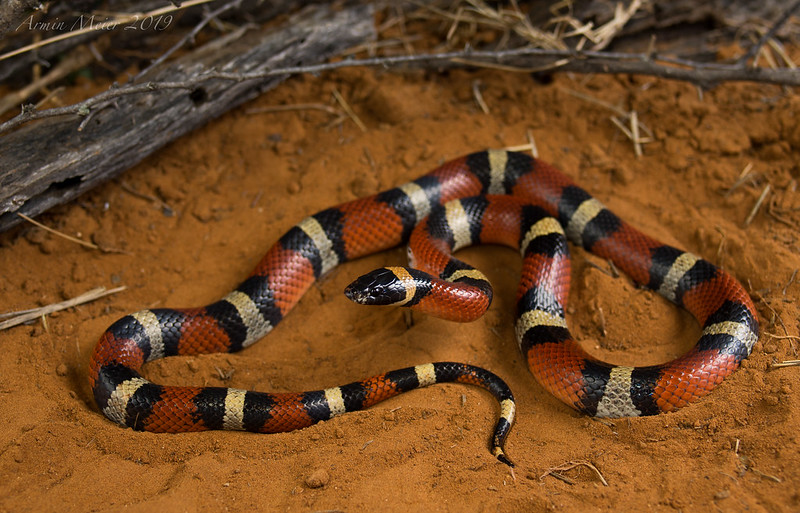
Dangerous or Not?
Bright red, black, and white bands run down its body, almost like it’s wearing a warning label. It looks eerily similar to the infamous coral snake, and you’ll find it slithering through woodlands, barns, and even suburban gardens across North and Central America.
Is it a venomous lookalike—or the real thing?
Answer: Harmless
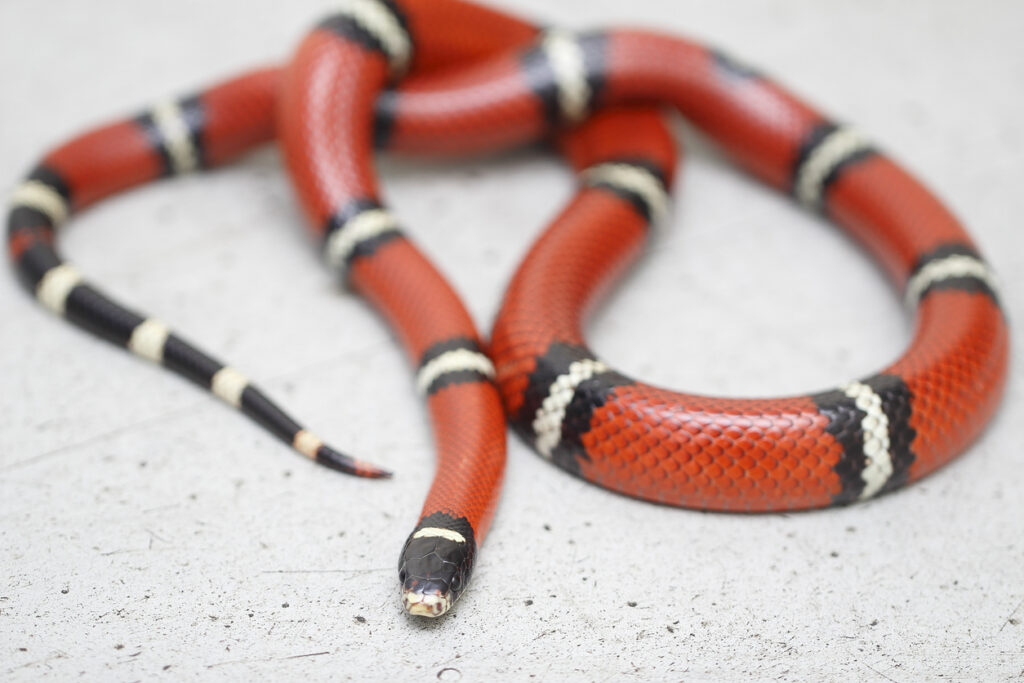
The milk snake is a classic mimic, borrowing its color scheme from the deadly coral snake to deter predators. However, this beauty is 100% non-venomous and perfectly safe for humans to handle. It’s a type of kingsnake, known for actually eating other snakes, even venomous ones.
Named from the old myth that they suck milk from cows (they don’t), milk snakes are common in barns and fields, where they help control rodent populations. One of the easiest ways to tell them apart from a coral snake is with the classic rhyme: “Red touch black, friend of Jack.” The red bands touch black, not yellow, so it’s safe.
Fun fact: Milk snakes are popular in the pet trade because of their striking looks and calm temperament, but in the wild, their best defense is pretending to be something much more dangerous. Source: Smithsonian’s National Zoo & Conservation Biology Institute
Snake #5: Russell’s Viper
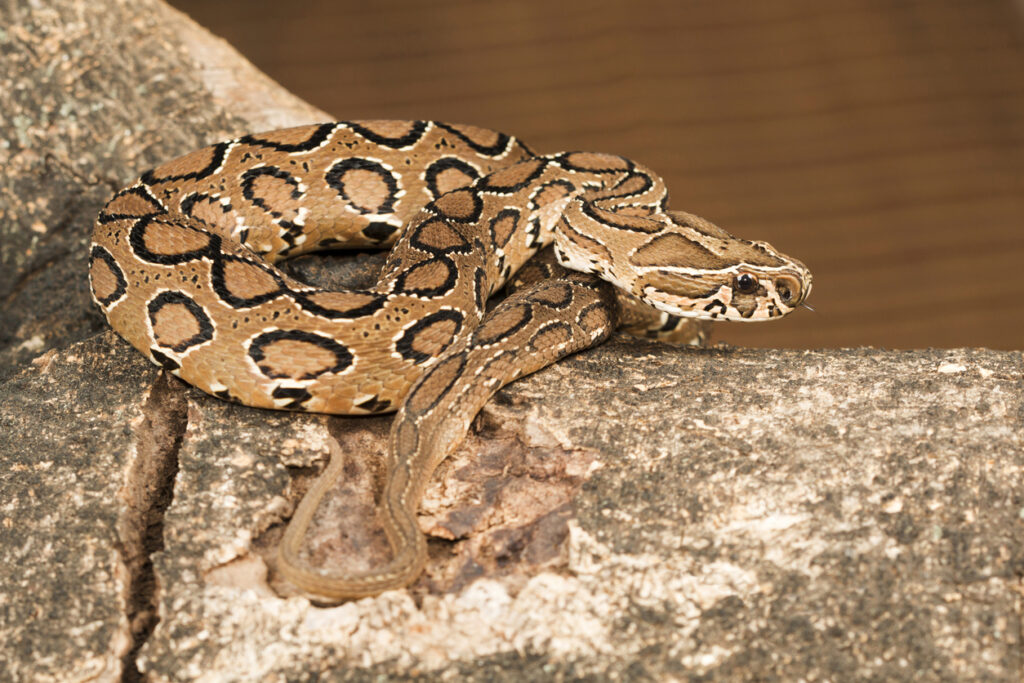
Dangerous or Not?
It doesn’t look flashy, no bright colors, no dramatic hood, but it’s responsible for more deaths in Asia than almost any other snake. Found in fields, farmlands, and even urban edges, it freezes when approached and may not strike right away.
So, is this a quiet neighbor—or a hidden killer?
Answer: Dangerous
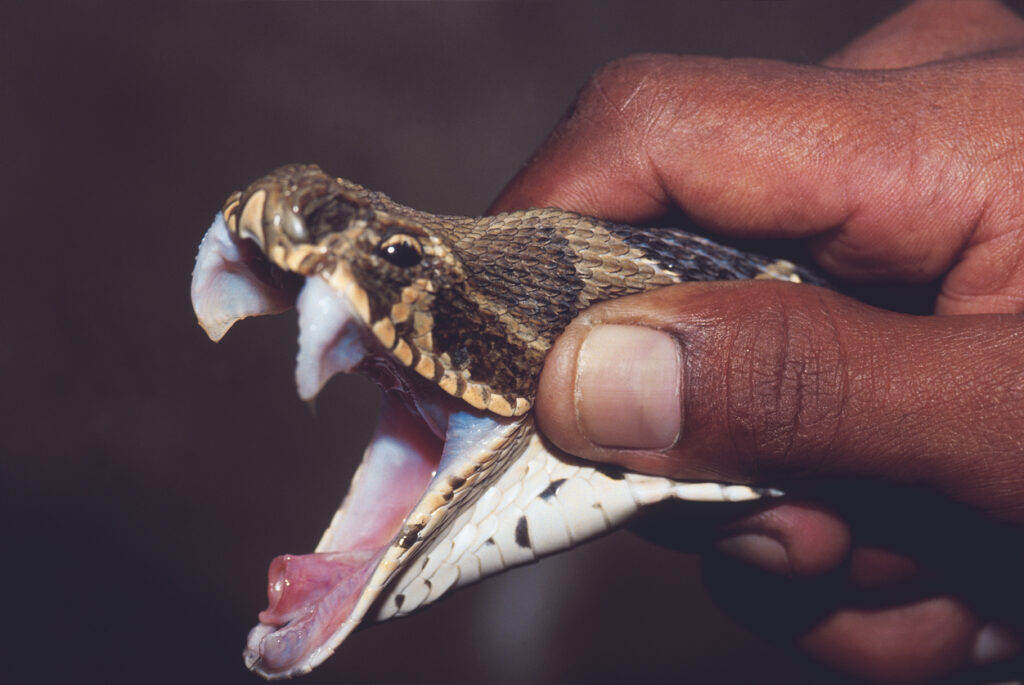
The Russell’s viper is one of the most dangerous snakes in the world, not because it seeks out humans, but because it often lives among them. Native to the Indian subcontinent and Southeast Asia, it’s highly venomous and responsible for thousands of bites annually. Its venom causes massive internal bleeding, kidney failure, and severe tissue damage, and without quick treatment, mortality rates can be alarmingly high.
One of the deadliest things about this snake? It’s a delayed strike. It often lies perfectly still when threatened, only to lash out when you’re too close. Farmers, children, and even city dwellers frequently cross its path unknowingly, especially at night.
Fun fact: The Russell’s viper has a hissing sound so loud, it’s been mistaken for a pressure cooker. And in some areas, it accounts for up to 43% of all snakebite fatalities. Source: World Health Organization
Snake #6: Green Tree Python
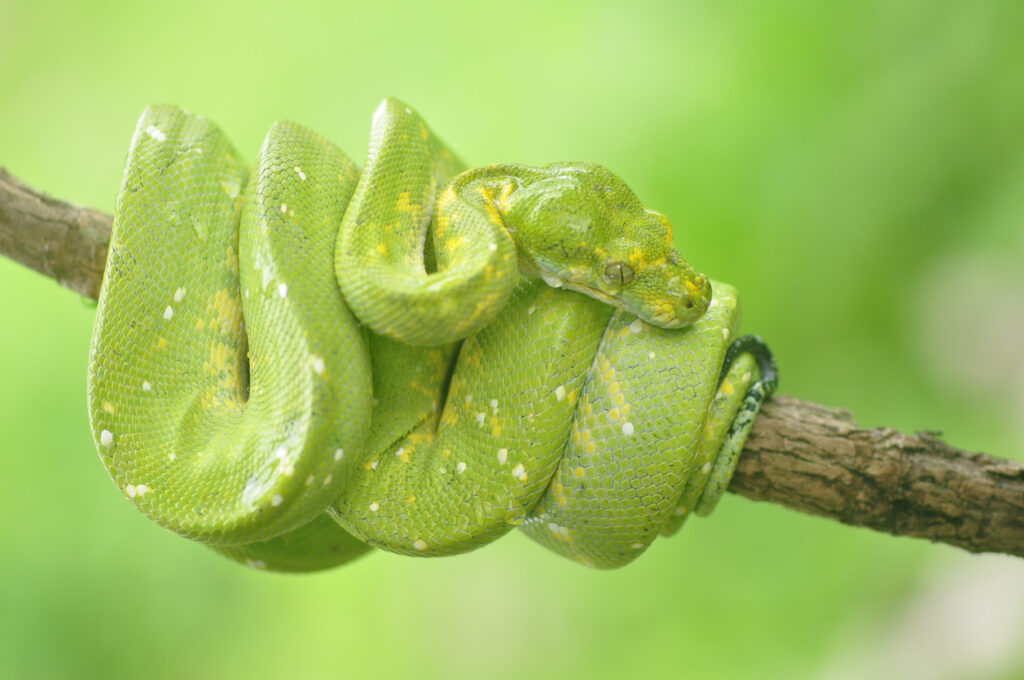
Dangerous or Not?
Its electric green scales, golden eyes, and slow-motion movements give it an almost alien beauty. You’ll spot it curled like a ribbon on tree branches in Australia and New Guinea, rarely touching the ground. But looks can be deceiving, so what do you think?
Jungle gem—or venomous surprise?
Answer: Harmless
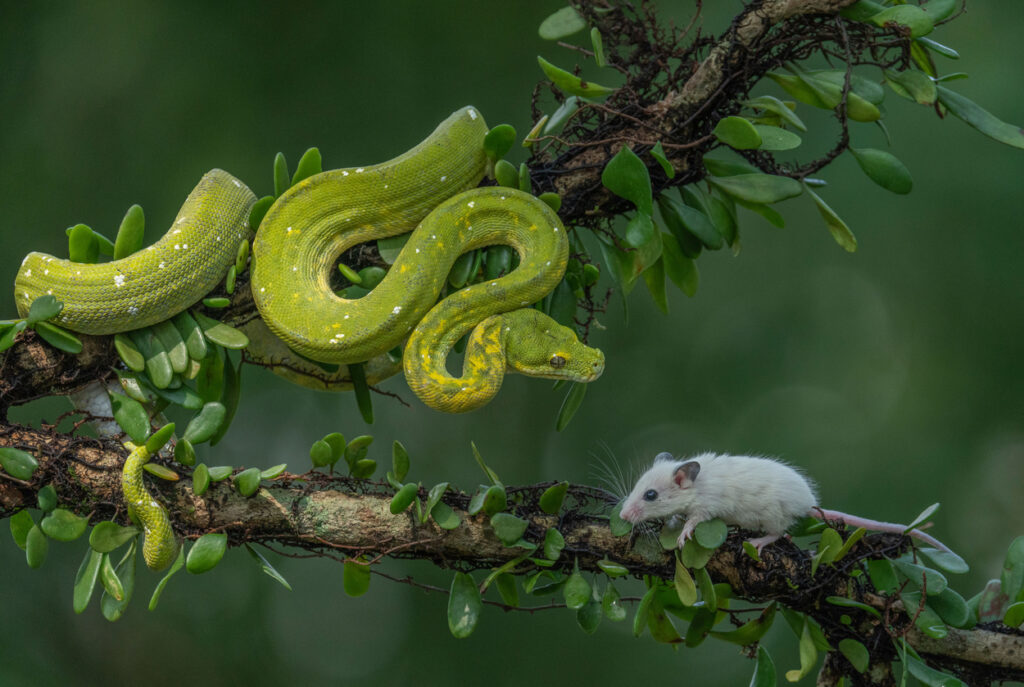
Despite its exotic appearance and piercing stare, the green tree python is non-venomous and harmless to humans. It’s a constrictor, like a boa, meaning it kills prey by squeezing, not biting with venom. It spends nearly its entire life in the trees, feeding on birds, bats, and small mammals, often ambushing them from above.
These snakes are especially striking because of their color changes: juveniles can be bright yellow, orange, or red, only turning green as they mature. While they may bite if threatened, the bite is nonvenomous and rarely serious. They’re a favorite in the exotic pet world, prized for their calm nature and incredible color.
Fun fact: The green tree python and the South American emerald tree boa look almost identical, but they evolved separately. That’s convergent evolution, and it’s one of nature’s most astonishing copy-paste tricks. Source: Australian Museum
Snake #7: Saw-Scaled Viper

Dangerous or Not?
It’s small, often under two feet, and doesn’t look particularly intimidating. But this little snake has a secret: when threatened, it rubs its body scales together, creating a rasping, “sizzling” sound like sandpaper on fire. Found in dry, dusty regions of Africa and Asia, it’s often seen near villages and roads.
So, is this the sound of danger—or just desert drama?
Answer: Dangerous
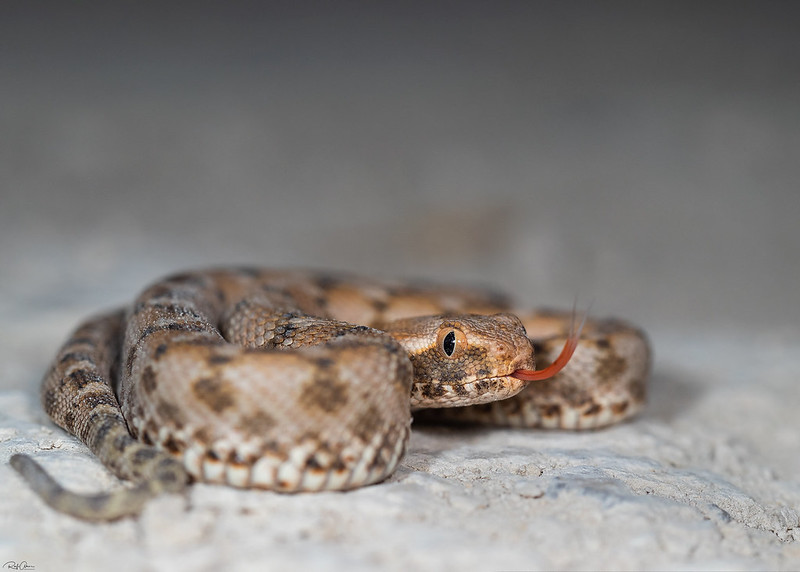
Don’t let its size fool you, the saw-scaled viper is one of the deadliest snakes in the world, and is responsible for more human deaths annually than any other species. Found from North Africa to India, it often hides under rocks, in shoes, or near homes, making it dangerously easy to surprise. Its venom is cytotoxic, causing massive tissue damage, internal bleeding, and coagulopathy (clotting failure).
One major reason it’s so lethal? High contact with humans and delayed treatment. In many areas, medical care or antivenom is hours away. The bite itself may be small, but the effects escalate quickly, especially in children or if left untreated.
That sizzling noise it makes? It’s a warning, created by rubbing special serrated scales against each other. If you ever hear it, back away slowly; this snake rarely bluffs.
Fun fact: It’s one of the few venomous snakes that give live birth instead of laying eggs. iNaturalist
Snake #8: Banded Krait
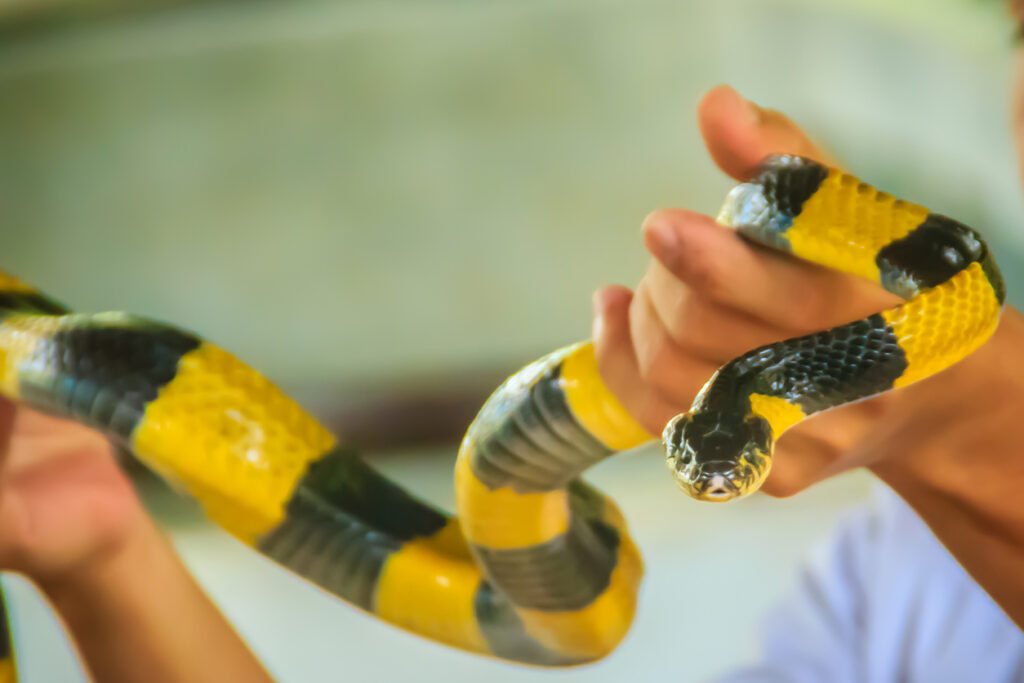
Dangerous or Not?
With its glossy black-and-yellow stripes and thick, slow-moving body, this snake looks more like a tropical warning sign than a stealthy predator. Found across India and Southeast Asia, it often glides through rice fields or dense vegetation at night.
Is this nature’s caution tape—or just another harmless mimic?
Answer: Dangerous
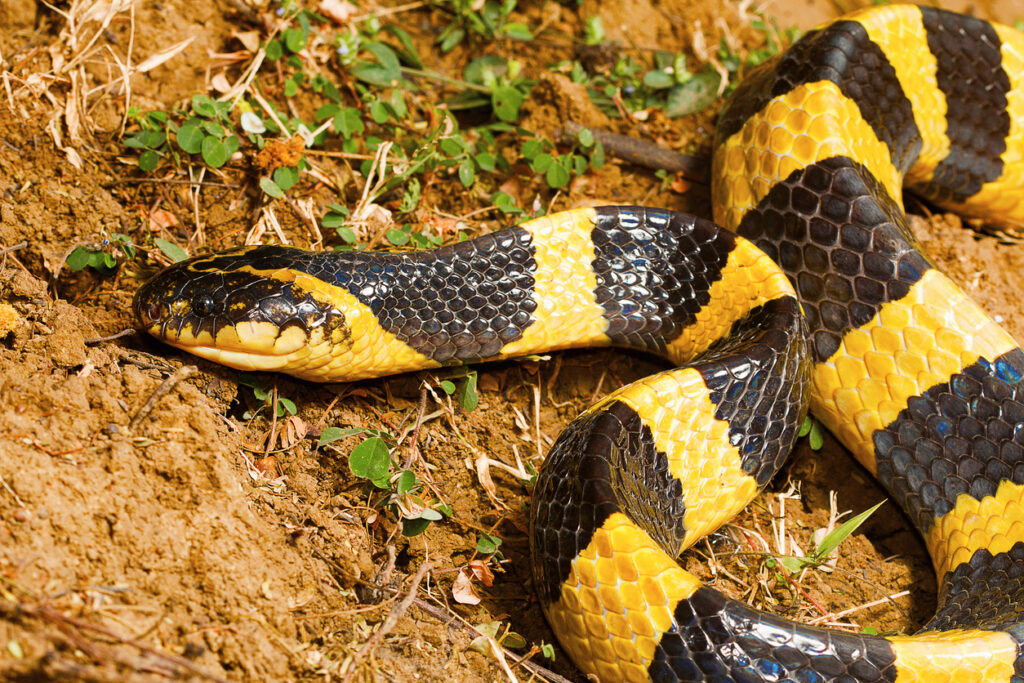
The banded krait is highly venomous, and while it’s shy and rarely aggressive, its bite can be fatal. It belongs to the elapid family, like cobras and coral snakes, and its venom is neurotoxic, capable of paralyzing the muscles used to breathe. What makes it especially dangerous is that it often bites people at night while they’re sleeping on the ground; victims sometimes don’t wake up.
Despite its power, the banded krait is slow-moving and prefers to avoid conflict. During the day, it hides under logs or in burrows. But don’t be fooled by its calm appearance; its venom is potent enough to kill a human with a single bite, though envenomation is rare due to its passive nature.
Fun fact: The krait’s glossy, lacquered appearance comes from smooth scales that reflect light, which may help it camouflage under moonlight or near water. Source: IRE Journals
Snake #9: Inland Taipan (a.k.a. The Fierce Snake)

Dangerous or Not?
You probably haven’t heard it hiss—or seen it in person. This secretive snake lives deep in Australia’s outback and rarely crosses paths with humans. But scientists have tested its venom, and the numbers are off the charts.
So, is this the shyest snake in the world—or the deadliest?
Answer: Dangerous
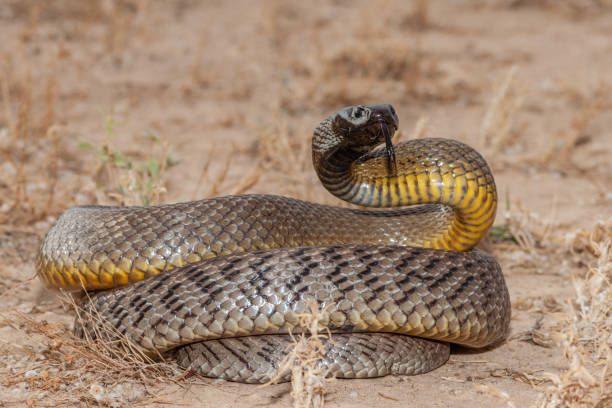
The inland taipan holds the title of most venomous snake on Earth; its venom is so toxic that a single bite could kill over 100 people or 250,000 mice. It’s packed with neurotoxins, hemotoxins, and myotoxins, creating a devastating cocktail that shuts down the nervous system, causes internal bleeding, and dissolves muscle tissue.
But here’s the twist: it’s also incredibly reclusive and rarely bites humans. Found only in the remote floodplains of western Queensland and South Australia, it lives in deep cracks and clay soils, emerging mostly during cooler mornings. Even herpetologists call it “gentle,” and bites are virtually unheard of outside of captive settings.
Fun fact: Its nickname, the “fierce snake,” refers to the potency of its venom, not its behavior. In the wild, it prefers to flee rather than fight, making it one of the least dangerous of the most dangerous snakes. Source: Australian Museum
Snake #10: Western Diamondback Rattlesnake
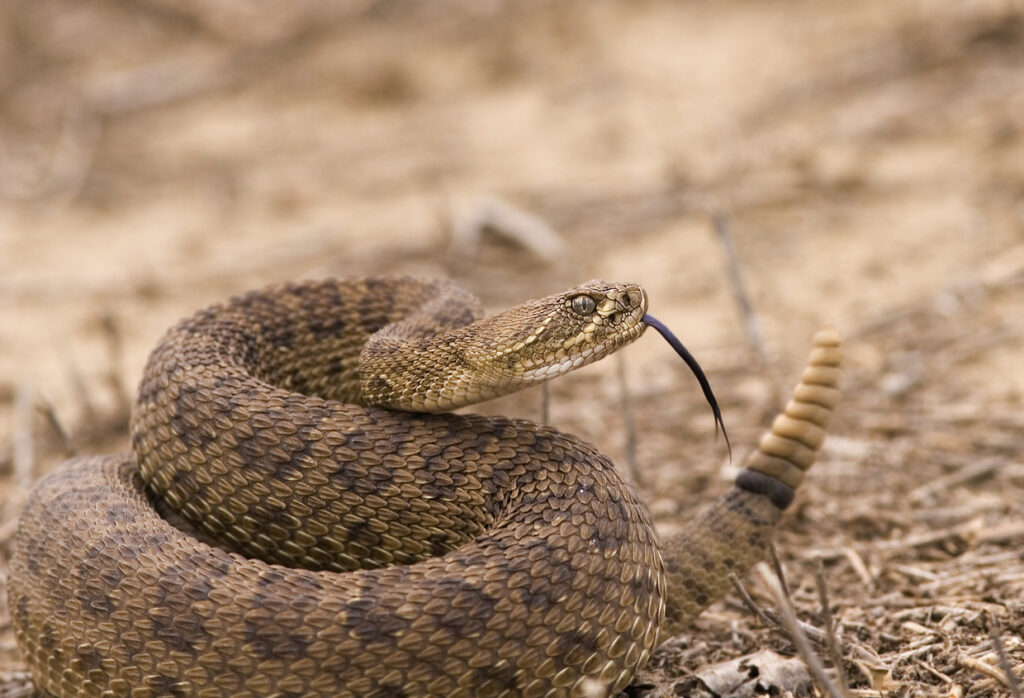
Dangerous or Not?
This one doesn’t sneak up on you; it warns with a dry, buzzing rattle that can be heard from several feet away. Common across the American Southwest, it’s thick-bodied, beautifully patterned, and often coiled in the shade of cactus or rock.
Is that rattle a bluff—or a serious warning you’d better not ignore?
Answer: Dangerous
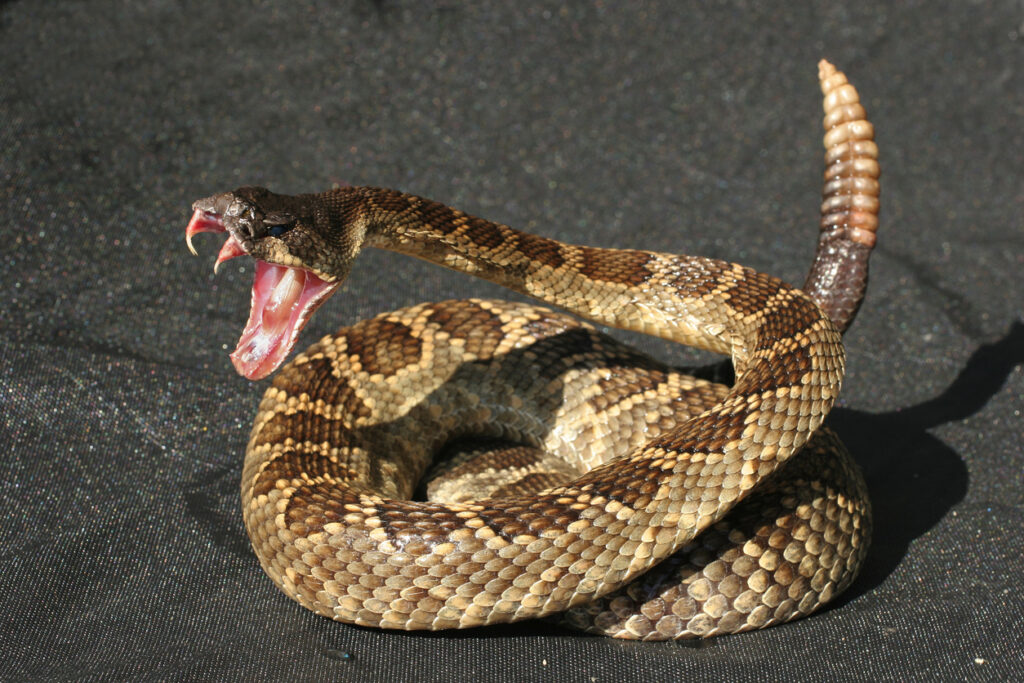
The western diamondback is one of North America’s most dangerous and iconic venomous snakes. Known for its loud rattle and defensive posture, it rarely strikes without warning, but when it does, it delivers a hemotoxic venom that destroys tissue, disrupts blood clotting, and can lead to serious infections or even amputation if untreated.
This species is responsible for the majority of venomous snakebites in the U.S., especially in Texas, Arizona, and New Mexico. It’s not unusually aggressive but will stand its ground when cornered. The rattle? It vibrates at up to 50 times per second, powered by special muscles that don’t fatigue easily, an evolutionary alarm system to warn off larger animals, including humans.
Fun fact: Diamondbacks help keep rodent populations in check, and many bites happen when they’re accidentally stepped on. Cowboy boots weren’t just a fashion statement; they were partly designed to defend against these. Source: U.S. Forest Service
Snake #11: Brahminy Blind Snake
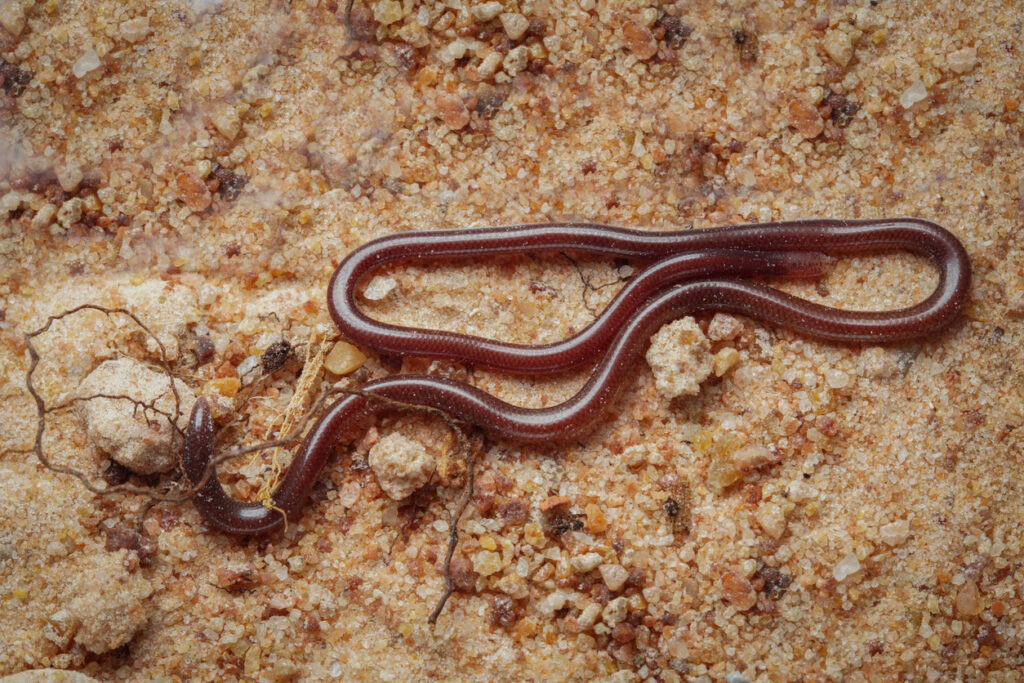
Dangerous or Not?
It resembles a shiny, wavy shoelace. You’ll find it under flowerpots, mulch, or sidewalk cracks in tropical and subtropical cities around the world, even in places where snakes aren’t usually welcome. But is this tiny intruder something to fear?
Your call: harmless garden visitor—or creepy crawler with a bite?
Answer: Harmless
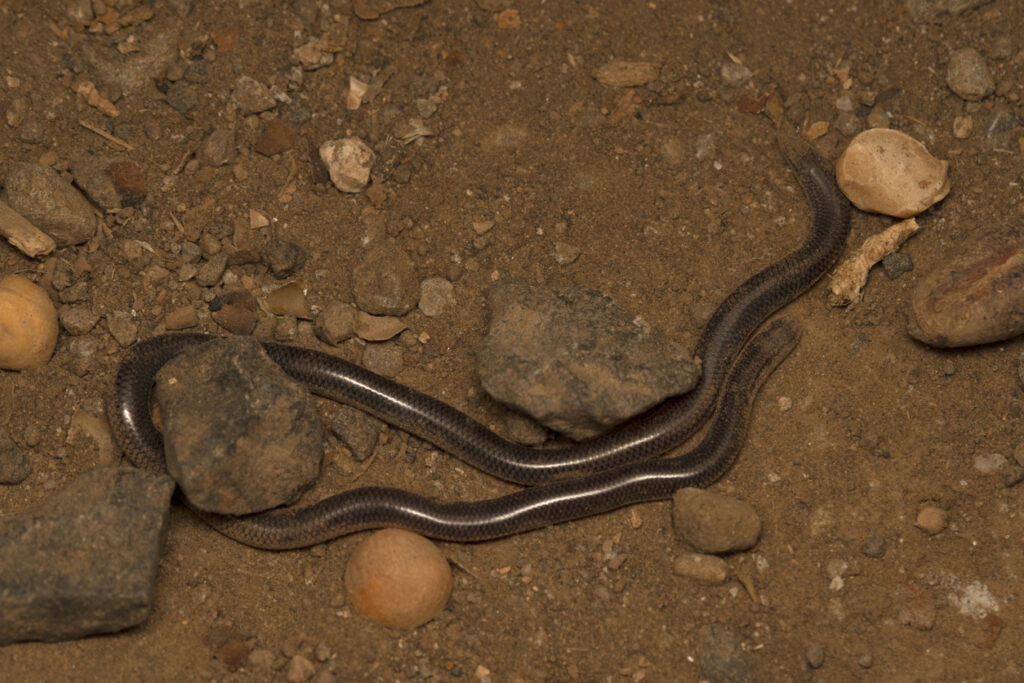
The Brahminy blind snake is entirely harmless; in fact, many people mistake it for an earthworm. Measuring only about 4 to 6 inches long, it features tiny, barely visible eyes and a smooth, metallic body, designed for burrowing. It doesn’t bite, strike, or even open its mouth in defense. And unlike most snakes, it’s parthenogenetic, which means every individual is female and reproduces without mating.
Originally native to Southeast Asia, this species has now spread worldwide via potted plants and soil, earning it the nickname “flowerpot snake.” You’ll find them in Florida, Hawaii, Africa, Australia, anywhere warm and damp. They feed on ant larvae and termites, quietly working underfoot and out of sight.
Fun fact: Because they reproduce asexually and are so adaptable, Brahminy blind snakes are considered one of the most successful invasive reptiles in the world, and yet almost no one ever notices them. Source: Florida Museum
Snake #12: African Rock Python
Dangerous or Not?
It’s one of the largest snakes on the planet, powerful enough to swallow a goat, and occasionally, even something bigger. Found near waterholes and grasslands across sub-Saharan Africa, this heavyweight prefers ambush over chase.
Is it a gentle giant – or a genuine threat to life and limb?
Answer: Dangerous
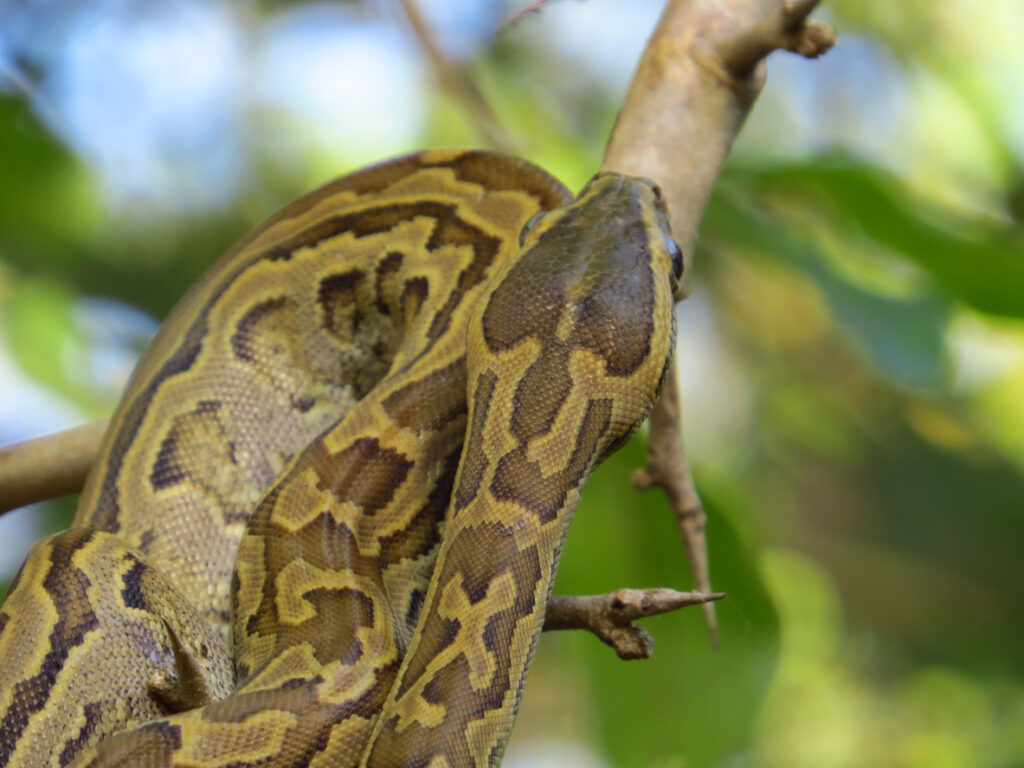
The African rock python isn’t venomous, but it can be extremely dangerous due to its sheer strength and aggression. It’s Africa’s largest snake, sometimes exceeding 20 feet in length and over 200 pounds. Like all pythons, it kills by constriction, wrapping around its prey and squeezing until circulation stops. It can take down antelopes, crocodiles, and in rare documented cases, even humans.
Although not typically confrontational, rock pythons have a reputation for unpredictable behavior, especially when cornered, nesting, or defending a recent kill. In some rural areas, they’re feared not just for their size but for their willingness to strike without provocation.
Fun fact: Unlike many other large snakes, the African rock python will sometimes stand its ground against humans rather than slither away. And unlike most pythons, its bite is notoriously painful, with long, recurved teeth that can cause deep punctures. Source: Wisconsin Herpetological Association
Snake #13: Blue Malayan Coral Snake
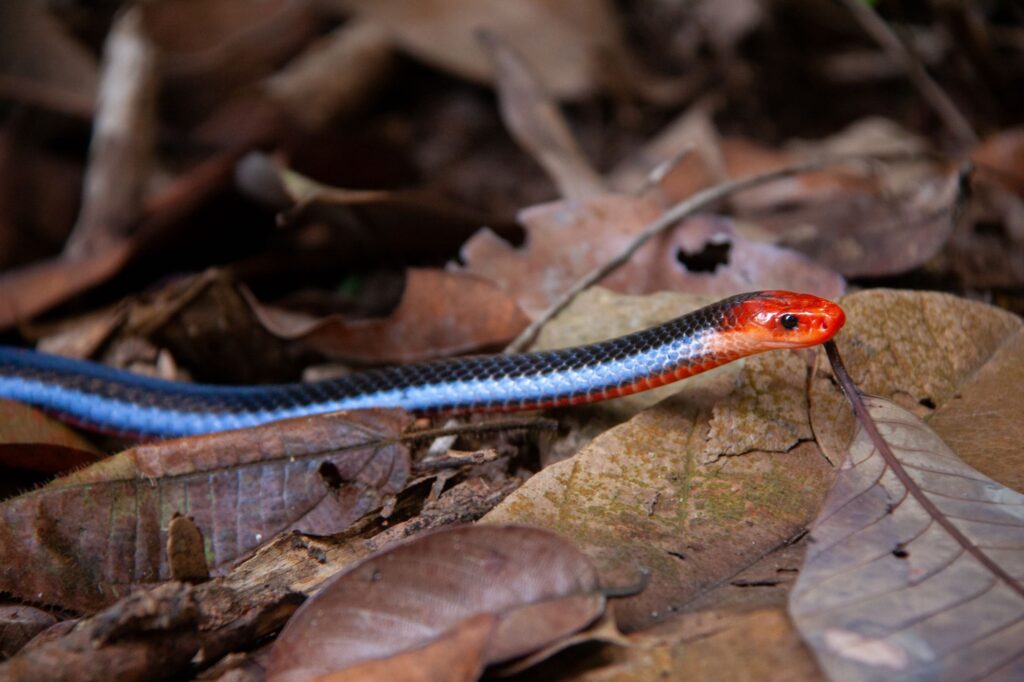
Dangerous or Not?
It’s hard to miss: a neon-blue body, crimson-red head and tail, and a habit of gliding through forest leaf litter like something out of a sci-fi movie. Found in Southeast Asia’s rainforests, it’s beautiful—and almost never makes noise.
Is it all color and no consequence, or hiding a high-voltage threat?
Answer: Dangerous
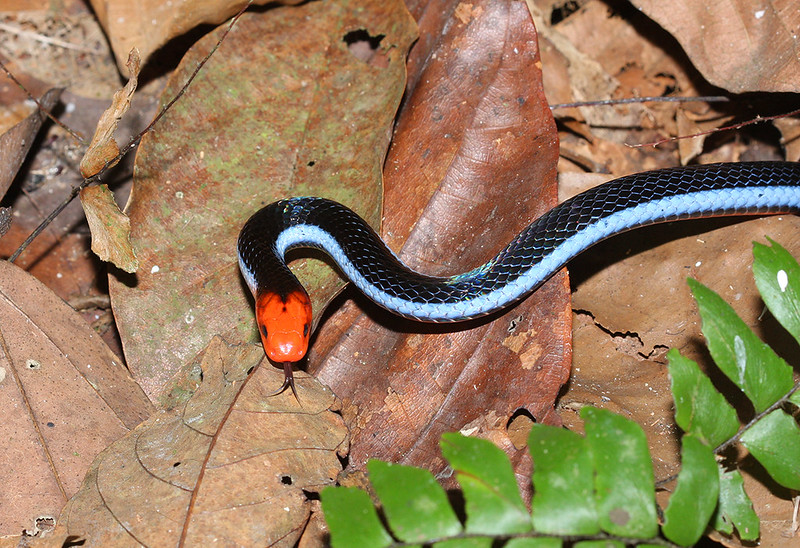
The blue Malayan coral snake is as deadly as it is dazzling. Its venom contains potent neurotoxins that cause instant and irreversible nerve overstimulation, leading to paralysis, seizures, and death. What makes this species especially terrifying is its venom’s speed; it doesn’t just block nerves, it sends them into overdrive, which can lead to fatal convulsions within minutes.
It preys on other snakes, including cobras, and has evolved to act fast. With its tiny fangs located far back in the mouth, it doesn’t look like a threat, but once it bites, there’s little time to react. Bites to humans are extremely rare due to its reclusive nature, but no antivenom exists, making it especially feared among herpetologists.
Fun fact: It has one of the longest venom glands of any snake, running nearly a quarter of its body length. This snake is proof that in nature, bold colors often mean bold danger. Source: Science Direct
Snake #14: Garter Snake
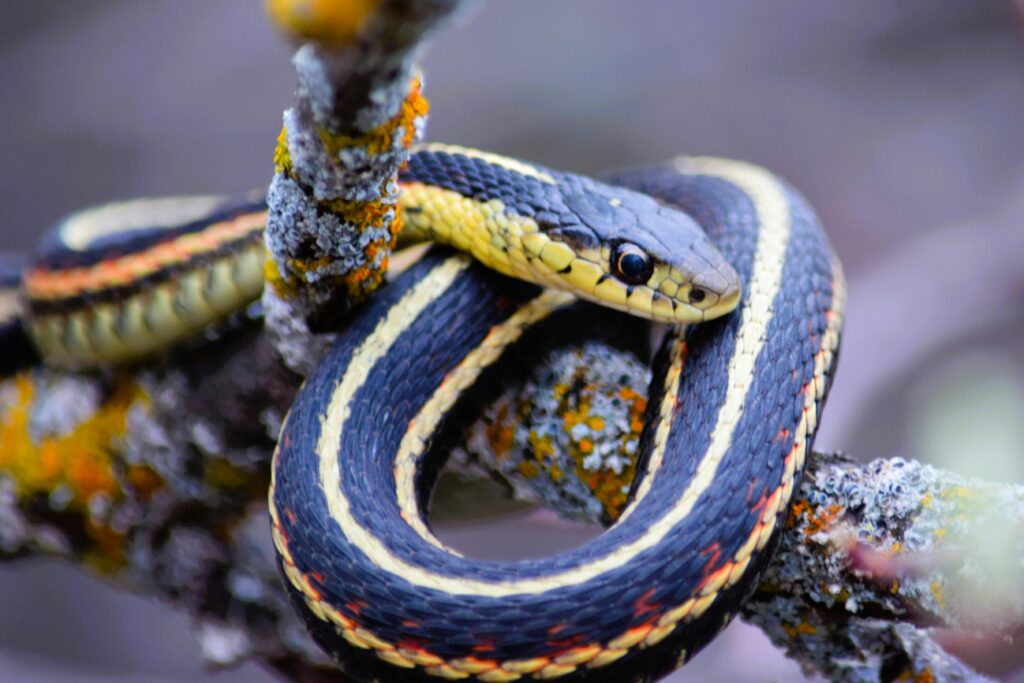
Dangerous or Not?
It’s small, common, and often spotted sunning itself on sidewalks or darting through backyard gardens across North America. With its signature yellow stripes and quick, twitchy movements, this snake is familiar to many, but does familiarity mean safety?
Friend of gardeners—or a stealthy danger in plain sight?
Answer: Harmless
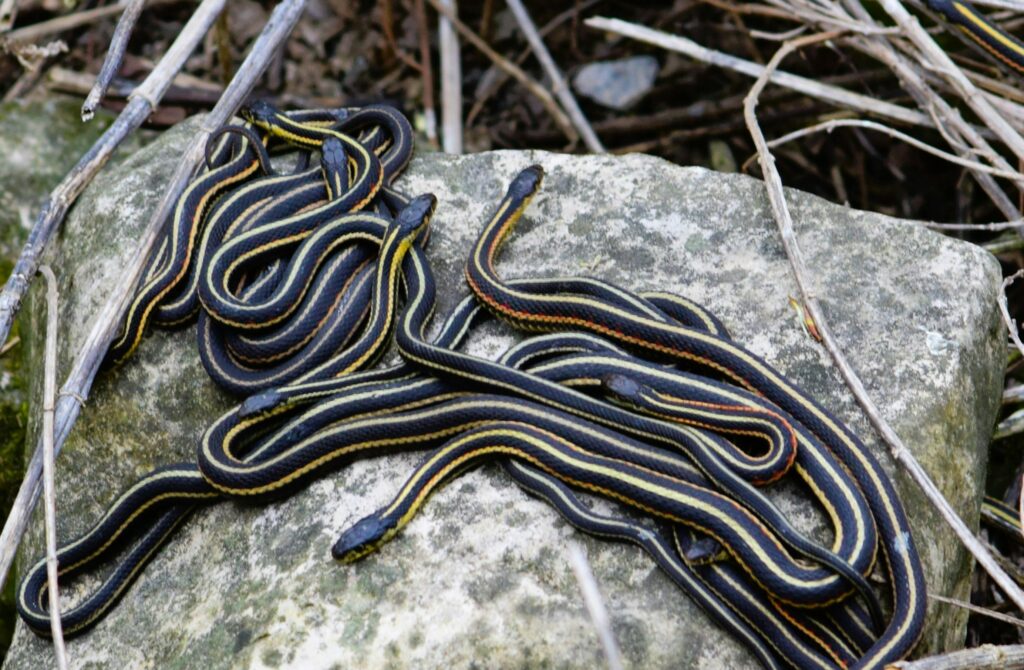
The garter snake is mostly harmless, but it’s not completely drama-free. Found from Canada to Central America, these common snakes do produce a mild venom in their saliva, but it’s only dangerous to small prey like amphibians, worms, and slugs. For humans, a bite might cause mild swelling or irritation, but that’s about it, and many garter snakes don’t even bite when handled.
They’re valuable members of the ecosystem, helping control pests in gardens, farms, and forests. Some species have evolved a bizarre trick: they can eat toxic newts and store the poison in their bodies, making them mildly toxic to predators like birds. This makes them one of the few snakes that are both venomous and poisonous, though again, only in the tiniest way.
Fun fact: During spring mating season, garter snakes form “mating balls” where dozens of males swarm a single female. It looks chaotic, but it’s just romance, reptile-style. Source: National Park Service
Snake #15: King Cobra
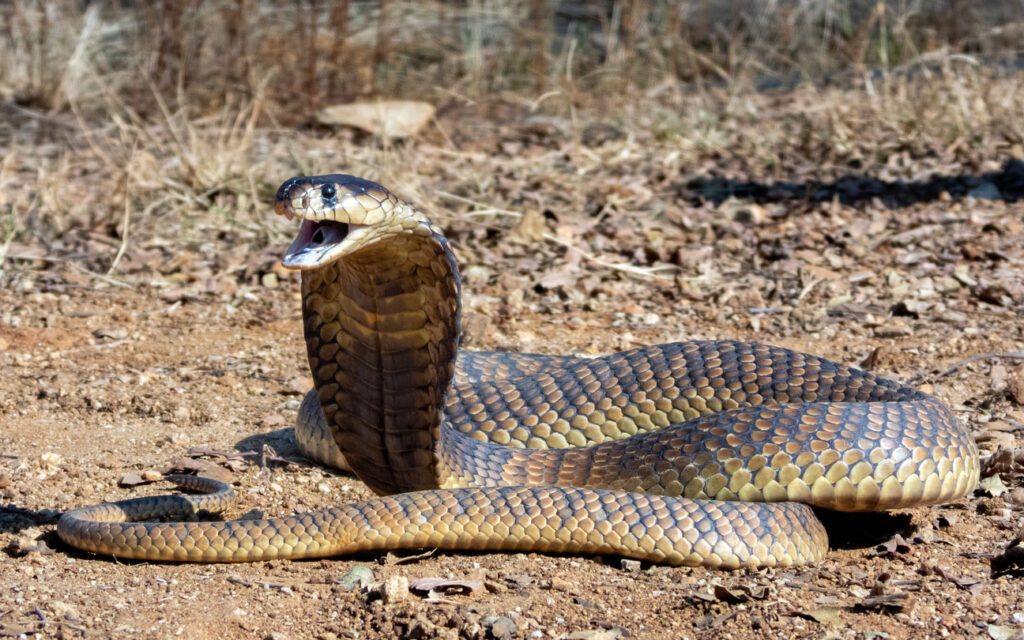
Dangerous or Not?
It raises its head high, flares an iconic hood, and stares straight into your soul. Found in forests and mangroves across Southeast Asia and India, this giant serpent is surprisingly shy, but when it strikes, it means business.
Is this regal reptile all reputation—or a legitimate reason to back away, slowly?
Answer: Dangerous
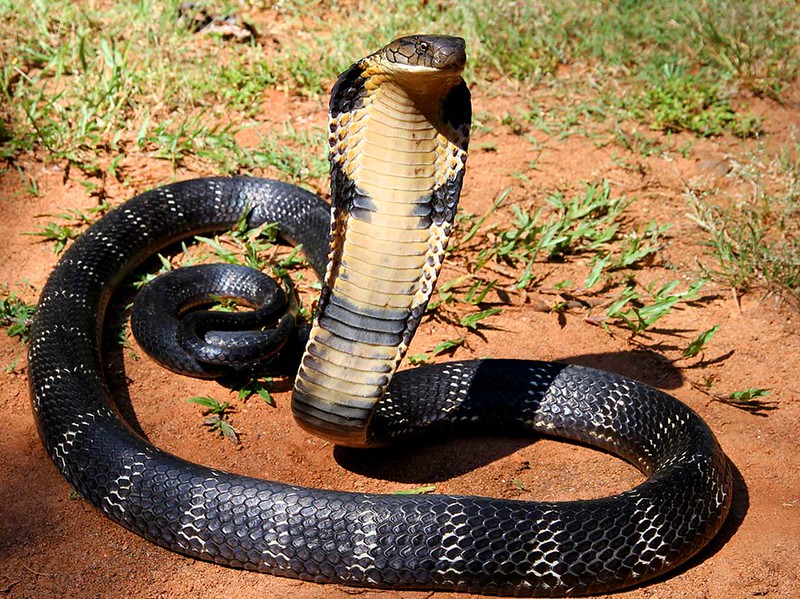
The king cobra is the world’s longest venomous snake, reaching up to 18 feet in length. Its venom isn’t the most potent drop-for-drop, but it delivers huge quantities, enough to kill an elephant or 20 humans in one bite. It attacks with a purpose: defending its territory or protecting its young (yes, it’s one of the only snakes that guards its nest).
Unlike other cobras, it doesn’t just strike and run. It may rise up to a third of its body length, spread its hood, and hold eye contact, a warning display few creatures ignore. Its venom attacks the central nervous system, causing blurred vision, paralysis, and death by cardiac arrest if not treated quickly.
Fun fact: The king cobra doesn’t just eat rodents; it specializes in eating other snakes, including venomous ones like kraits and pit vipers. That’s how it earned its name: it’s the king of snakes, literally. Source: Smithsonian’s National Zoo
Snake #16: Water Moccasin (Cottonmouth)
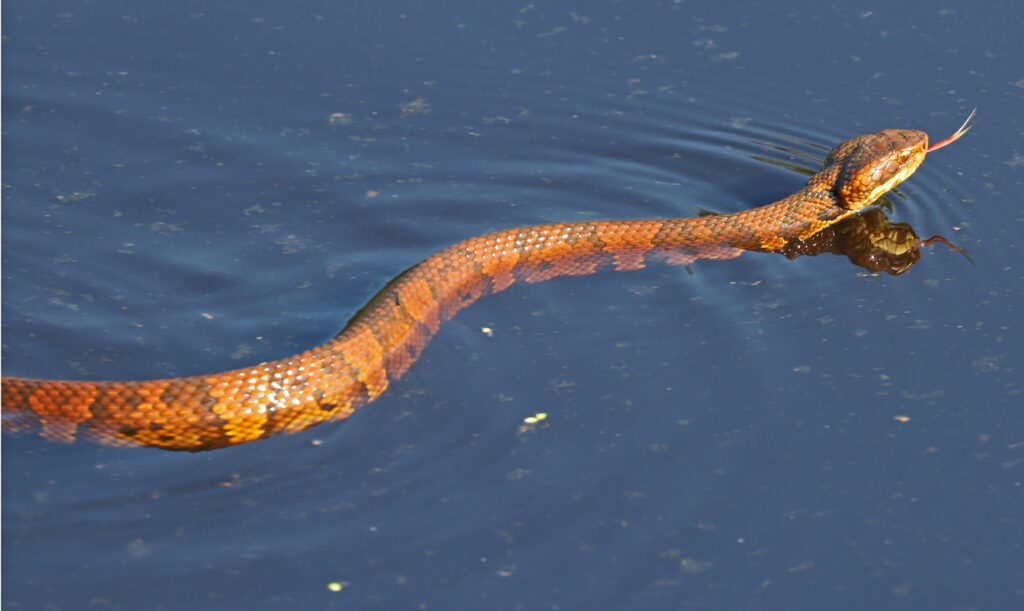
Dangerous or Not?
It swims in slow circles through murky swamps, its thick body gliding just beneath the surface. When threatened, it opens its mouth wide to reveal a startling white interior—like a warning flag you’d better not ignore.
Is it a drama queen—or a bite you’ll never forget?
(Image suggestion: A horizontal, realistic photo of a water moccasin near water’s edge or mid-mouth gape, showing the pale white “cotton” interior that gives it its name.)
Answer: Dangerous
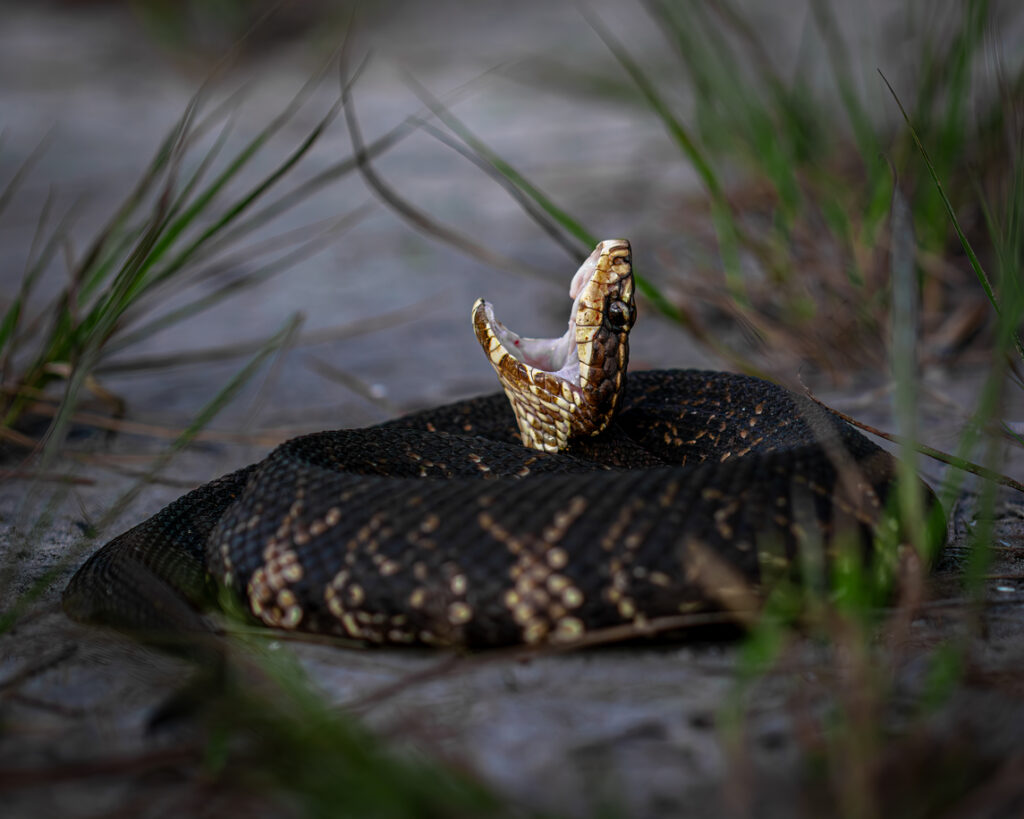
The water moccasin, also known as the cottonmouth, is venomous and aggressive, especially when compared to other North American snakes. Found in the southeastern U.S., it prefers slow-moving streams, swamps, and wetlands, often basking on logs or swimming with just its head above water. When threatened, it coils and gapes its mouth open, flashing the white interior as a vivid warning.
Its venom is cytotoxic, meaning it destroys tissue and can lead to severe swelling, infection, or even amputation. Though not usually fatal with prompt treatment, bites are often serious and extremely painful. Unlike many snakes, cottonmouths stand their ground and sometimes advance toward threats rather than retreat.
Fun fact: Juvenile cottonmouths wiggle their bright yellow tail tips like a lure to attract frogs and fish. It’s the swamp version of bait-and-switch, and it works. Source: University of Georgia Savannah River Ecology Laboratory
Snake #17: Red-Bellied Black Snake
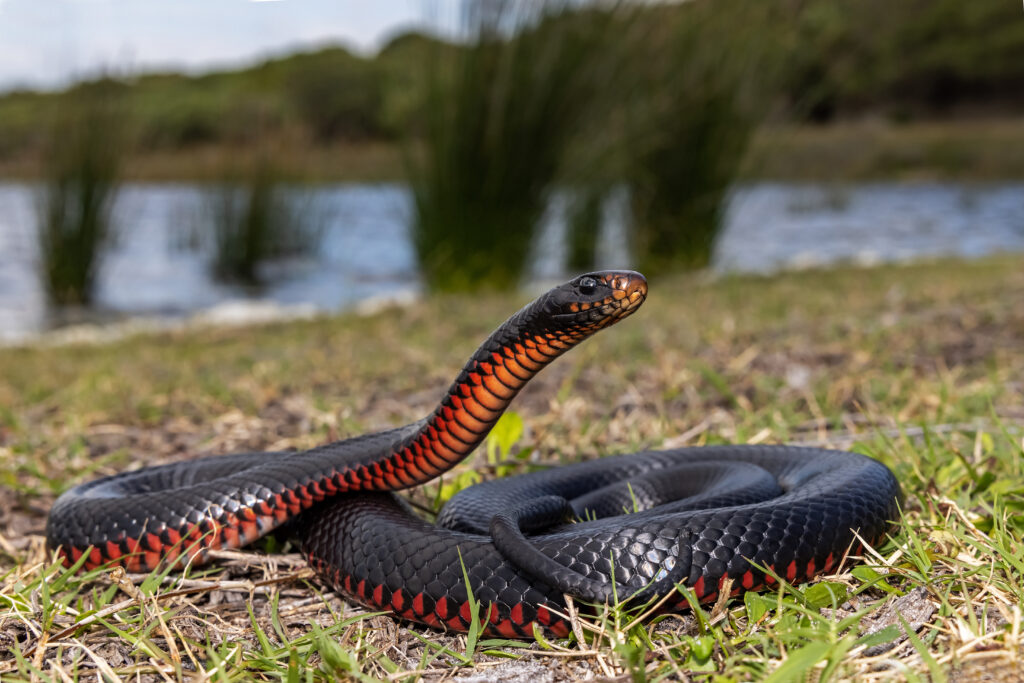
Dangerous or Not?
Glossy black on top, blazing red underneath, this sleek predator looks like it was designed to be noticed. Native to eastern Australia, it’s often found near freshwater creeks, marshes, and urban gardens, especially after a rainstorm. Though not known for chasing people, it can stand its ground when provoked.
Is this bright belly a serious warning—or just fashion without the fangs?
Answer: Dangerous
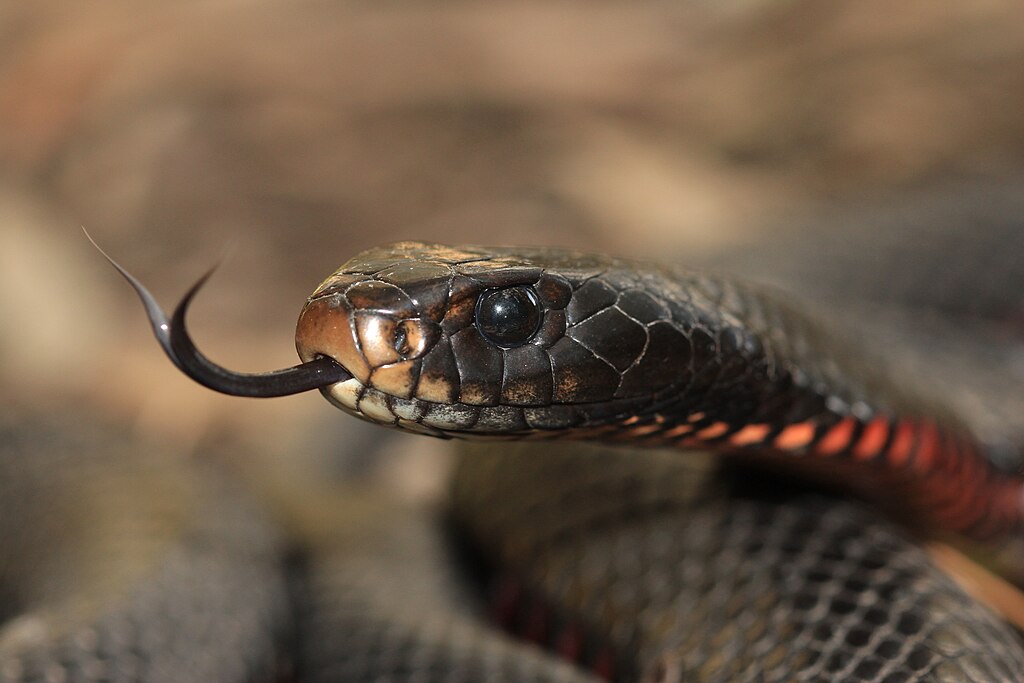
The red-bellied black snake is venomous, though rarely fatal. A member of the elapid family, it delivers a venom cocktail that includes neurotoxins, hemotoxins, and myotoxins, causing localized pain, muscle destruction, swelling, vomiting, and sometimes long-term tissue damage. Bites are rarely life-threatening thanks to fast access to antivenom in Australia, but without treatment, symptoms can become serious within hours.
This snake is considered one of Australia’s shyest and non-aggressive venomous species. It typically flees from humans but may bite if it feels cornered or stepped on. Its preferred habitats include wetlands, slow-moving streams, and forest edges, where it hunts frogs, fish, and small reptiles. It’s a capable swimmer and often active during the day, making encounters with people more likely.
Fun fact: Although dangerous, this snake has an unexpected ecological benefit; it’s one of the few species known to prey on juvenile eastern brown snakes, which are far more lethal. In a strange twist, this red-bellied beauty may reduce more dangerous encounters. Source: Australian Museum
Snake #18: Bullsnake
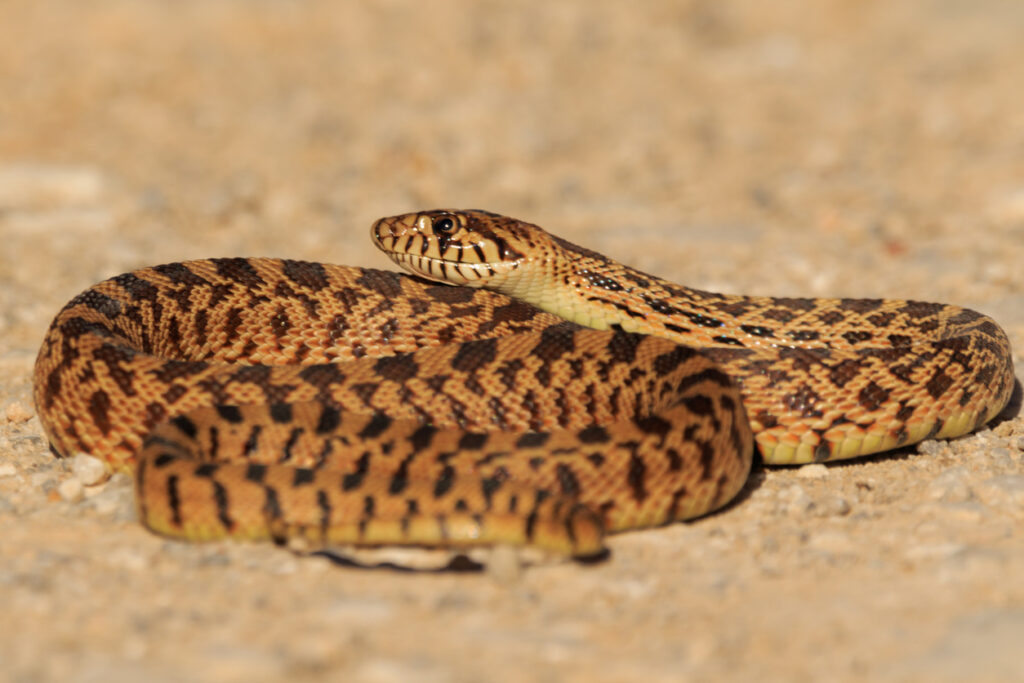
Dangerous or Not?
It hisses like a rattlesnake, coils into a strike pose, and even vibrates its tail in dry leaves to mimic that infamous rattle. Found across the central U.S. plains and deserts, this large-bodied snake doesn’t back down easily.
So—deadly deceiver or harmless impersonator?
Answer: Harmless
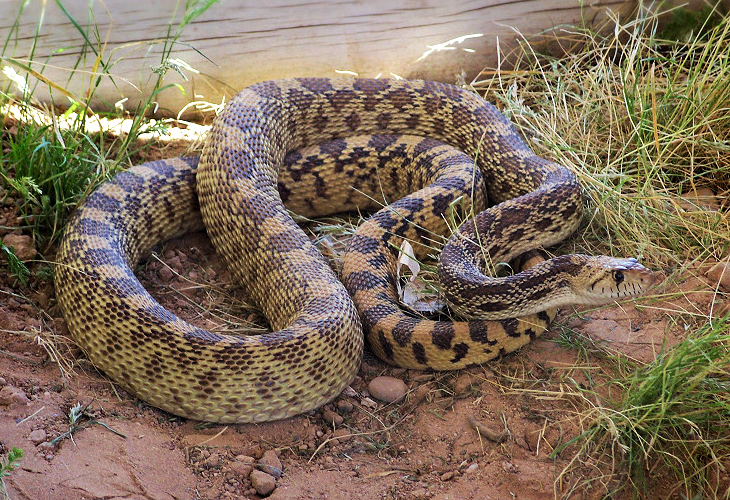
Despite the bluff and bravado, the bullsnake is completely nonvenomous. It’s one of the largest snakes in North America, reaching up to 8 feet long, and belongs to the same family as gopher and pine snakes. While it’s known for its aggressive display, loud hissing, tail shaking, and mock strikes, it’s all an act meant to deter predators, not attack people.
Bullsnakes are powerful constrictors and feed on rodents, birds, and eggs, making them valuable allies to farmers and gardeners. Their resemblance to rattlesnakes is so convincing that people often kill them out of fear, but they pose no threat to humans and rarely bite unless physically restrained.
Fun fact: Bullsnakes can flatten their heads and compress their windpipes to amplify their hiss, creating a sound that mimics the warning of a real rattler. It’s one of nature’s best imitations, and it often works. Source: Missouri Department of Conservation
Snake #19: Eyelash Viper
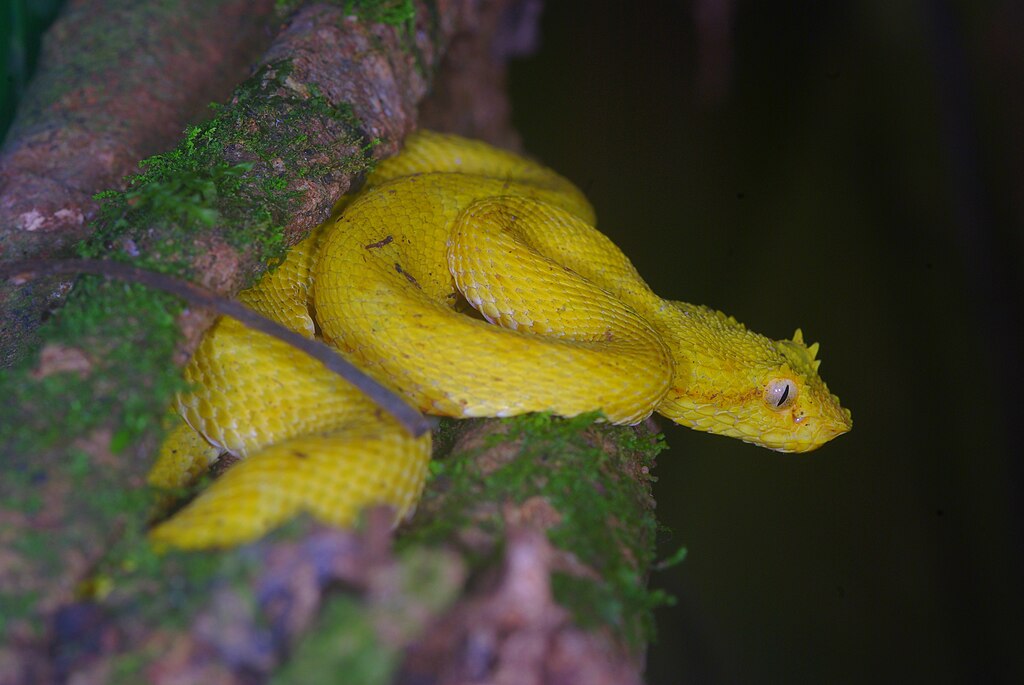
Dangerous or Not?
It’s tiny, tropical, and brightly colored, yellow, green, even pink, and it sports what look like miniature lashes above its eyes. Found coiled like a flower bud in trees across Central and South America, it’s undeniably photogenic.
Is this jungle beauty just for show—or dangerously real beneath the glam?
Answer: Dangerous
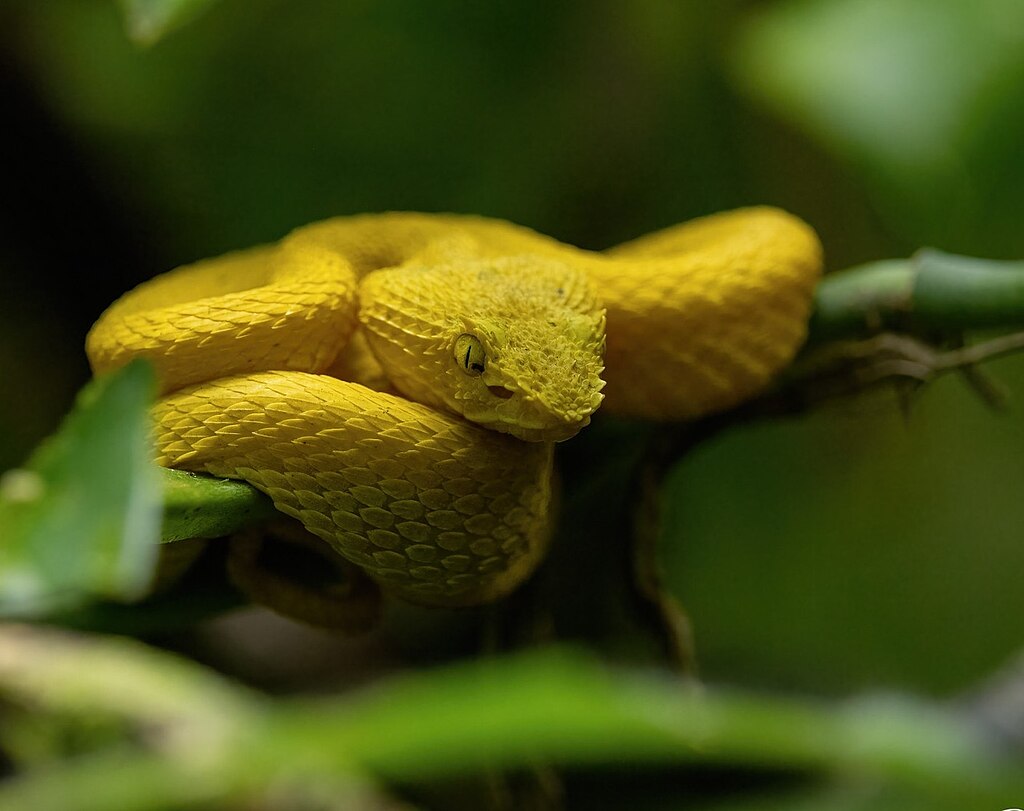
The eyelash viper may be small, usually just 2 feet long, but it’s venomous and potentially dangerous. A member of the pit viper family, it uses heat-sensing pits to detect prey, and delivers hemotoxic venom that causes pain, swelling, and tissue damage. While its bite is rarely fatal to healthy adults with treatment, it can be serious, especially for children or in remote regions where medical help is delayed.
This snake is an ambush predator, often sitting motionless on tree branches or inside flowers, waiting for frogs, lizards, or birds to pass by. Its “eyelashes” are actually modified scales, believed to help with camouflage by breaking up its outline among leaves and petals.
Fun fact: Eyelash vipers come in a wide range of vibrant colors, sometimes all within the same region, a phenomenon called polymorphism. Locals often refer to them as “ornamental snakes,” but there’s nothing decorative about their bite. Green Circle Experience
Snake #20: Brown Tree Snake
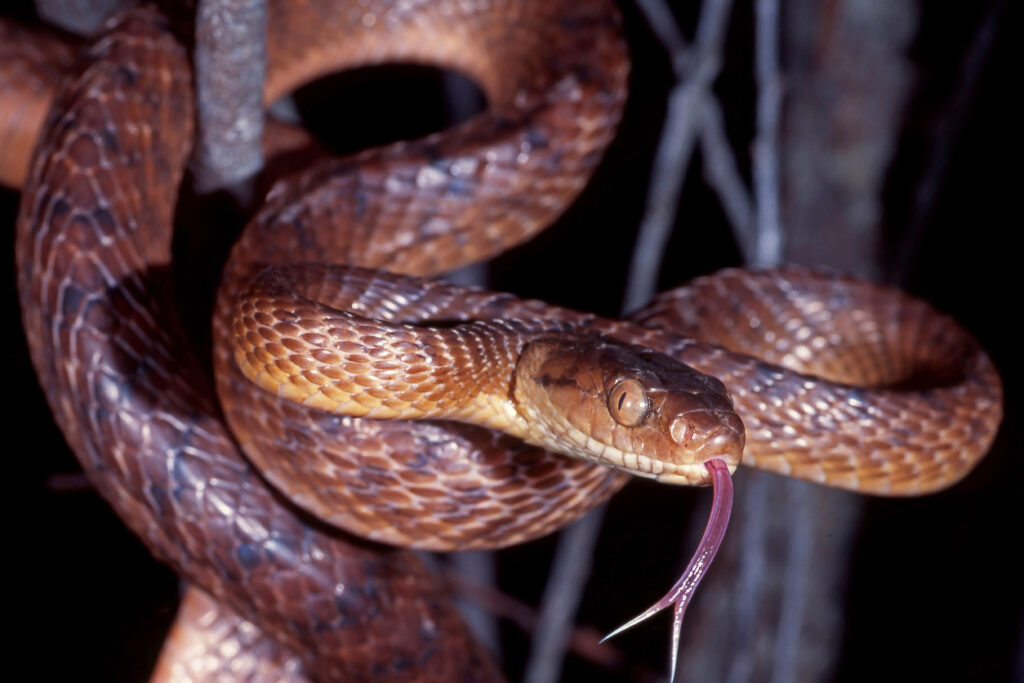
Dangerous or Not?
It slithered its way onto Guam decades ago, and the island’s birds have never recovered. Slim, quick, and mostly active at night, it moves through treetops with eerie grace and hangs from branches like jungle spaghetti.
Is it an ecological nuisance—or a serious threat to humans too?
Answer: Mildly Dangerous (to humans)—Ecologically Devastating
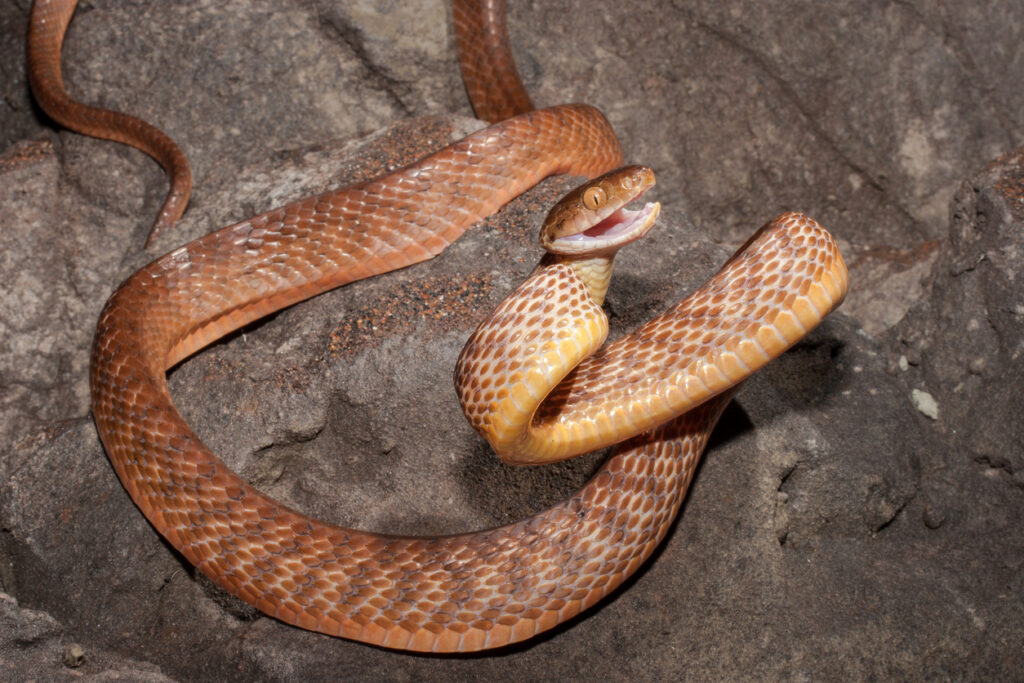
The brown tree snake is only mildly venomous to humans, but it’s one of the most ecologically destructive invasive species in the world. Native to Australia and parts of the Pacific, it arrived in Guam after World War II, likely stowed away on a military cargo ship. Since then, it’s wiped out over 90% of the island’s native bird population.
It’s rear-fanged, meaning it has to chew to inject venom, which usually only irritates humans. However, small children and pets are at a greater risk due to their tendency to enter homes and climb into the ceilings or electrical boxes. Its prehensile tail and climbing skills make it extremely difficult to contain, and it’s even been known to cause power outages on Guam by slithering across electrical lines.
Fun fact: The brown tree snake is so invasive that the U.S. government has airdropped dead mice laced with acetaminophen (a snake poison) across Guam to control the population. Source: U.S. Geological Survey (USGS)
Snake #21: Tiger Keelback
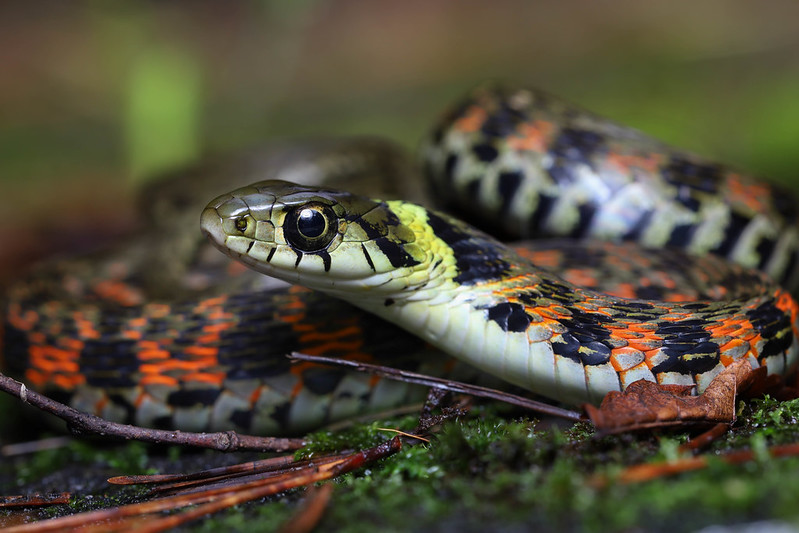
Dangerous or Not?
It’s small, brightly patterned, and found across Japan, Korea, and parts of China, usually near rice paddies and streams. Its head is mild-looking, its colors mimic danger, and it’s so calm that people often pick it up.
But is this tiger-striped snake a harmless poser—or hiding something lethal beneath the surface?
Answer: Dangerous—and uniquely so
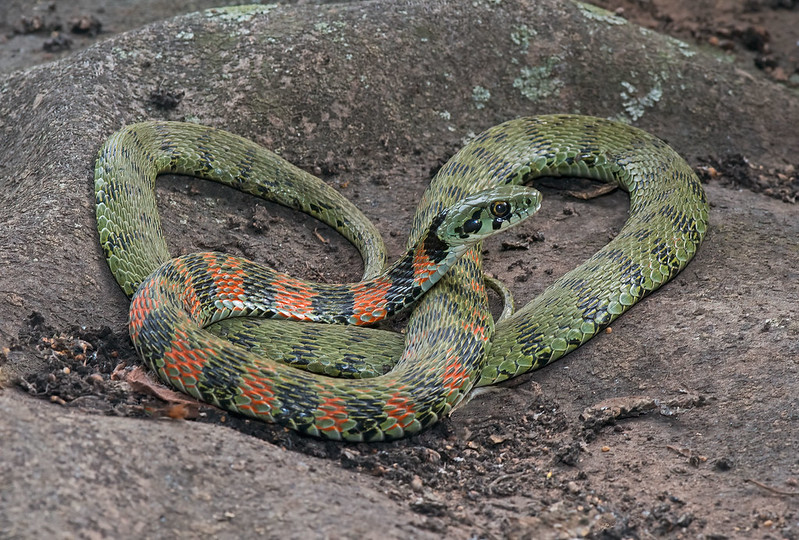
The tiger keelback is one of the very few snakes in the world that is both venomous and poisonous. Rear-fanged and slow to bite, its venom can cause internal bleeding and paralysis in lab animals. But what really makes it special is its ability to store toxins from the poisonous toads it eats, and secrete those toxins from glands in its neck when threatened.
That means this snake doesn’t just produce venom, it hijacks toxins from other animals and weaponizes them. And while human bites are rare, they’ve been serious: in one case, a Japanese schoolchild required intensive care after a tiger keelback bite.
Fun fact: The vivid orange-red “collar” behind its head serves as a warning to predators. And if threatened, it flattens its neck to expose those toxin glands, like a walking billboard that screams: “I’m not worth it.” Source: Journal of Toxicology: Clinical Toxicology
Snake #22: Sidewinder
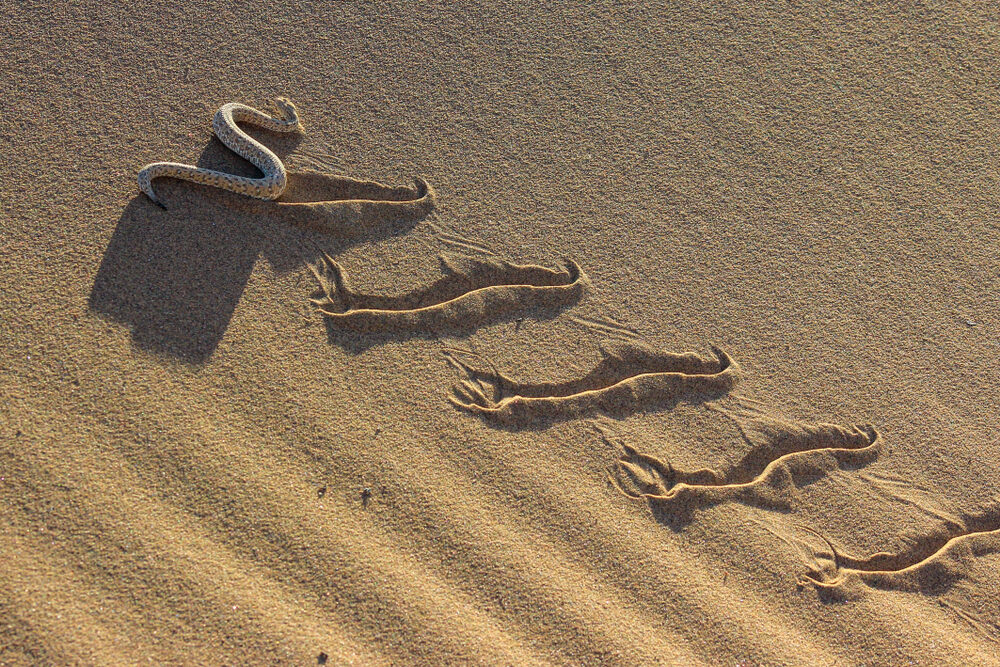
Dangerous or Not?
It slithers sideways across scorching sand, leaving J-shaped tracks in the dunes. With horns above its eyes and a quick, jerky motion, this small rattlesnake is a master of the desert. But despite the drama, it’s one of the easiest to miss.
Is this zigzagging desert dweller all speed—or also seriously dangerous?
Answer: Mildly Dangerous
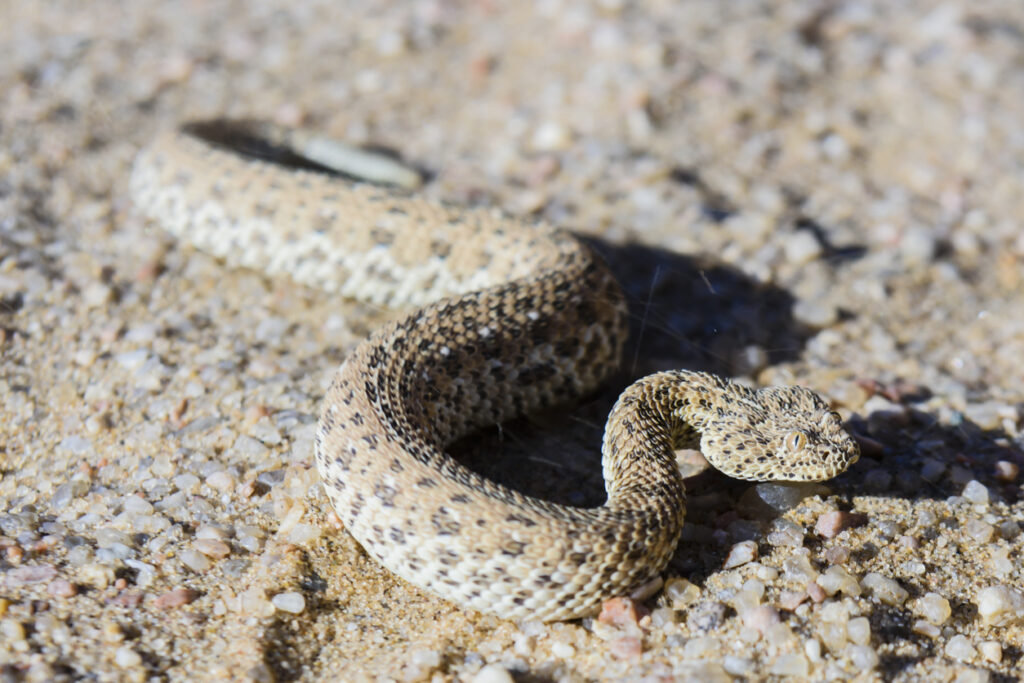
The sidewinder, a species of rattlesnake found in the deserts of the southwestern U.S. and northern Mexico, is venomous, but not as deadly as some of its relatives. Its venom is cytotoxic, causing pain, swelling, and tissue damage, but bites are rarely fatal with prompt medical care. Most experts consider it less dangerous than larger rattlesnake species, due to its smaller size and lower venom yield.
What makes the sidewinder so famous is its unique method of locomotion; it lifts parts of its body off the hot sand and moves sideways in rapid bursts. This not only keeps it cool but also allows it to move efficiently on loose terrain. Its horn-like eye scales may help protect its vision from blowing sand and intense sunlight.
Fun fact: The sidewinder can strike with lightning speed and bury itself in seconds, becoming nearly invisible, a survival skill that makes it both hard to spot and hard to forget. Source: Arizona-Sonora Desert Museum
Snake #23: Banded Sea Krait
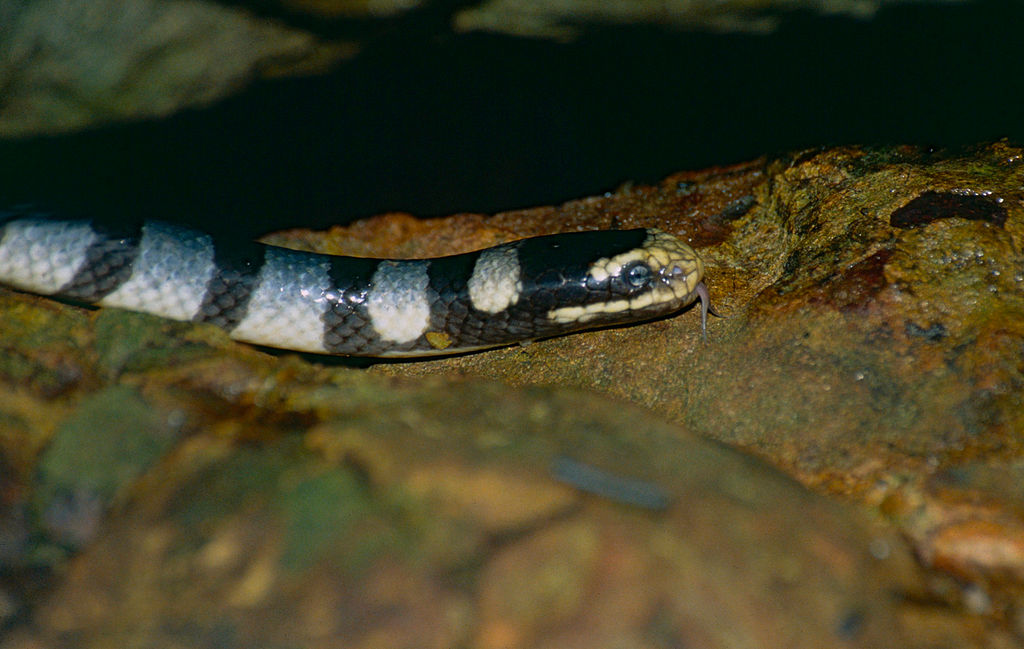
Dangerous or Not?
Its body moves like a ribbon in water, banded in black and white like a nautical flag. You’ll find it in the tropical waters of the Indo-Pacific, weaving through coral reefs and tidepools. It’s slow on land, but slick as silk in the sea.
Is this underwater striped swimmer a venomous nightmare—or just ocean decor with a spine?
Answer: Dangerous—but rarely to humans
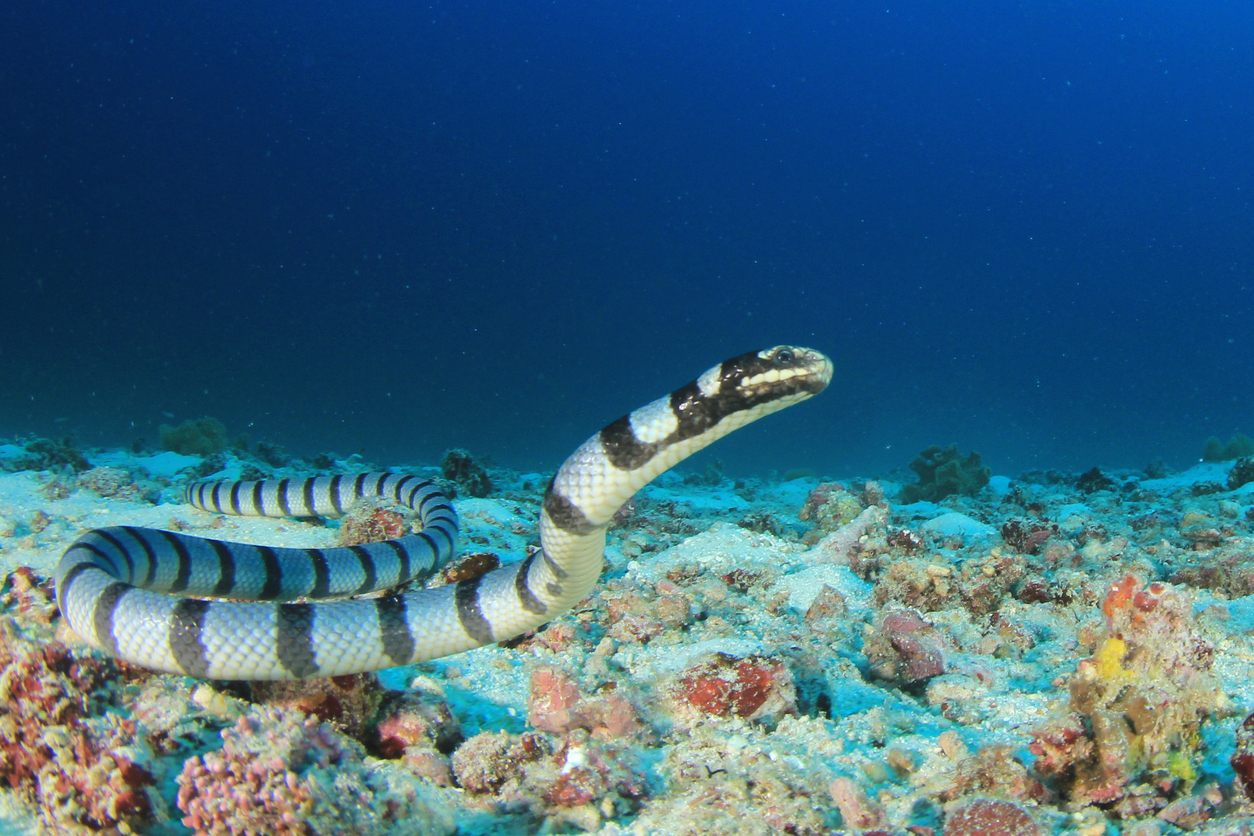
The banded sea krait is extremely venomous, with a bite estimated to be 10 times more toxic than a rattlesnake’s. It uses its venom to immobilize fish, eels, and squid in the reef. But here’s the catch: it’s incredibly docile and rarely bites humans, even when handled by divers or fishermen.
This amphibious snake spends much of its time in the water, but comes ashore to digest food, lay eggs, or rest. Its paddle-shaped tail makes it a powerful swimmer, and it can hold its breath for up to 2 hours. Because it often moves slowly on land, many people wrongly assume it’s harmless; however, a bite, although rare, can be deadly without antivenom.
Fun fact: Unlike fully aquatic sea snakes, kraits still breathe air and have lungs that stretch nearly the entire length of their body, helping them stay submerged for long periods. Source: Oceana
Snake #24: Black Mamba
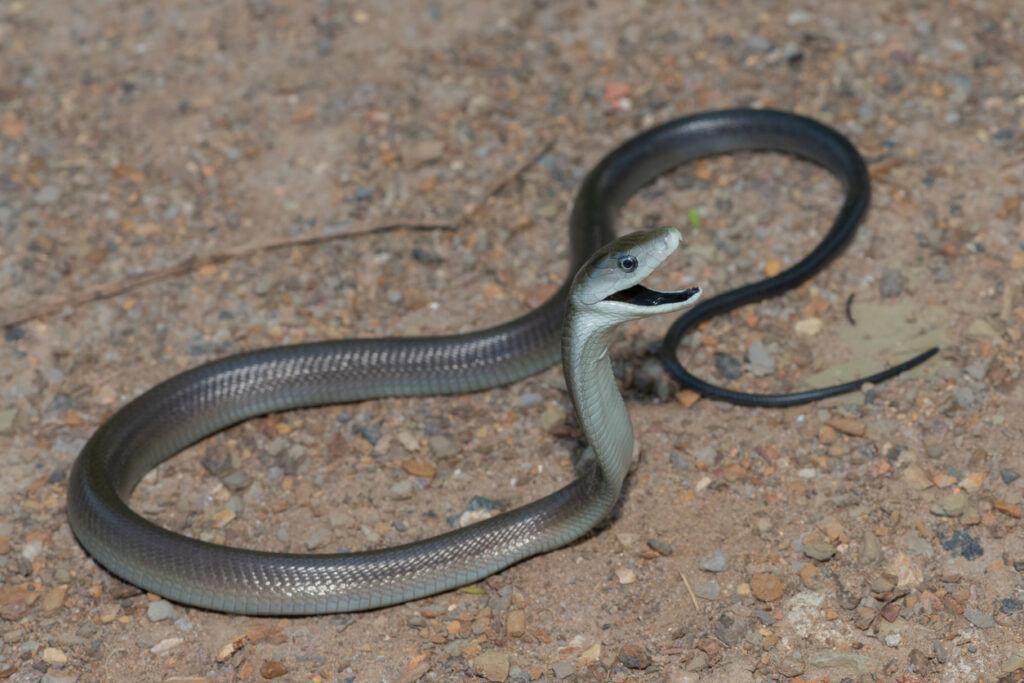
Dangerous or Not?
It doesn’t actually look black, it’s sleek, olive-gray, and moves like a whip. But when it opens its mouth? Pitch black. Found across sub-Saharan Africa, it’s fast, alert, and often feared more than any other snake on Earth.
Is this legendary killer as lethal as the hype, or just a misunderstood speedster?
Answer: Extremely Dangerous
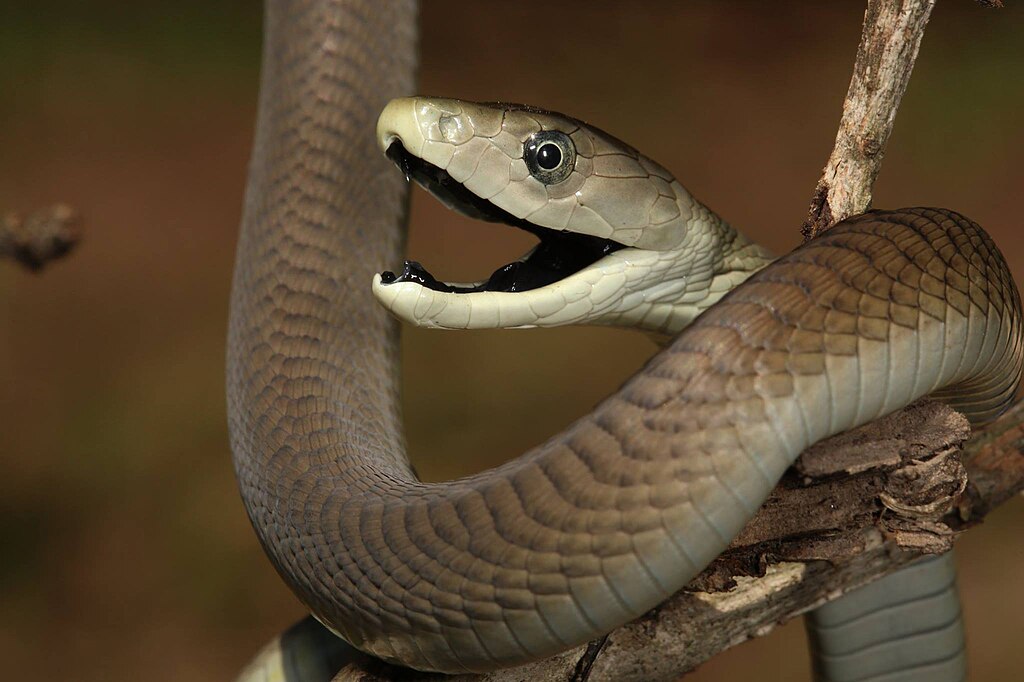
The black mamba is one of the fastest and deadliest snakes on the planet. It can reach speeds up to 12 mph, strike multiple times in seconds, and deliver a powerful neurotoxic venom that can kill an adult in under 30 minutes without treatment. Before antivenom became widely available, black mamba bites had a 100% fatality rate.
Despite its fearsome reputation, it’s not inherently aggressive. Most bites occur when people accidentally corner it or try to kill it. In the wild, it prefers flight over fight, but if threatened, it raises a third of its body, opens its inky-black mouth, and delivers warning strikes with terrifying speed and precision.
Fun fact: The “black” in its name comes not from its scales, but from the inky interior of its mouth, which it shows before striking—a final warning that few ignore and even fewer survive without medical help. Source: South African National Biodiversity Institute
So… How’d You Do?
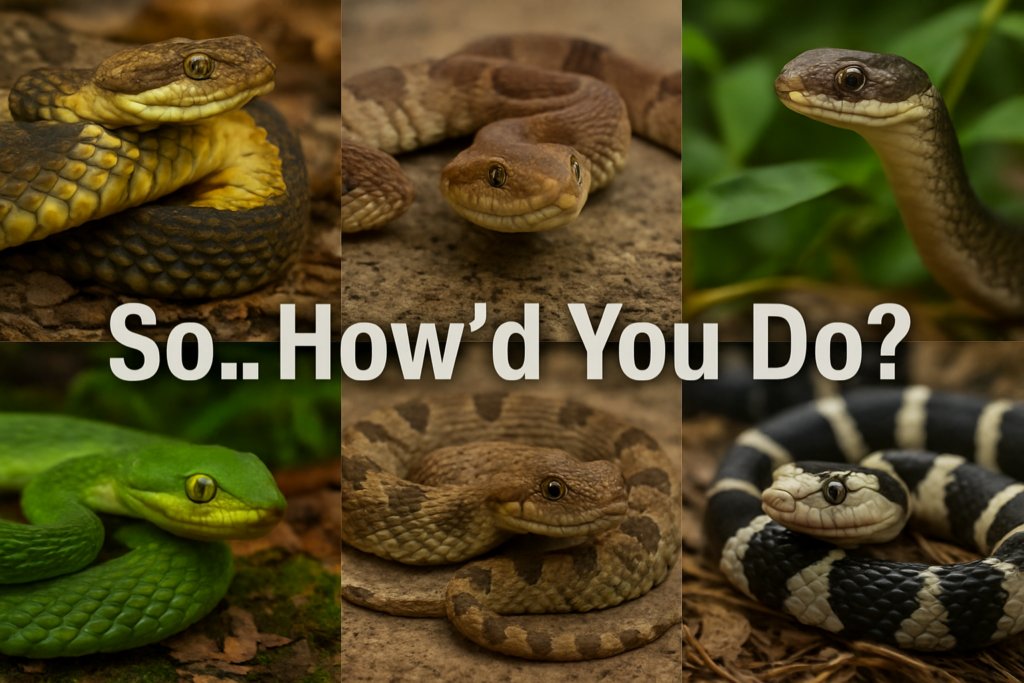
Some slither in silence. Others hiss, rattle, or flash colors like a stoplight. But now you know: not every scary snake is deadly, and not every small, quiet one is safe. From venomous sea serpents to harmless garden guardians, the snake world is full of surprises, mimicry, and misunderstood heroes.
Whether you aced the quiz or missed a few close calls, one thing’s clear: snakes aren’t out to get us. In most cases, they’d rather slip away than strike. Respect their space, know the signs, and you’ll be just fine.
Now that you’ve cracked the code on these 24 slithery suspects…
Would you step closer, or back away slowly?
This quiz, They All Look Scary, But Only Some of These 24 Snakes Are Truly Dangerous was first published on dailyfetch.net.


